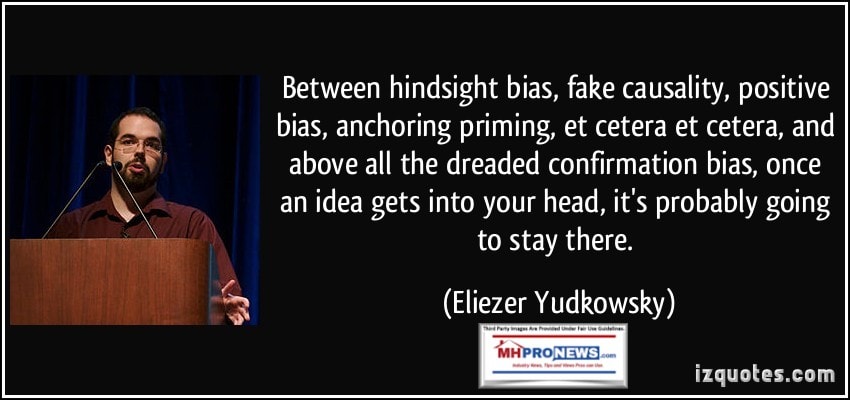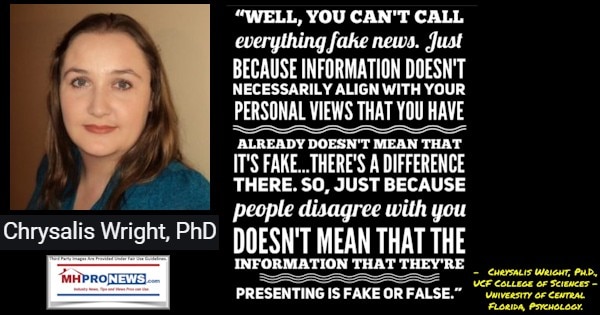
In an era of information overload, where seemingly everything is hyped, it is understandably easy for even attentive and impacted readers to misunderstand or downplay how much could be at stake. There is a very real threat of another round of serious price hikes on HUD Code manufactured homes. Given the various factors that have jacked up prices through arguably artificial/bad policy induced supply chain, labor shortages, ‘Bidenflation,’ and other factors, manufactured housing doesn’t need to have yet another set of expensive hikes added on top of those. Given the revelation last week based on documents obtained by a source at the Department of Energy (DOE) on what the actual role of the Manufactured Housing Institute (MHI) has apparently been driving from behind the scenes costly and unnecessary energy standards. Those standards, per reports, are not yet required for far more costly site built housing. Furthermore, on a whole house basis, manufactured homes are already less costly in energy usage compared to conventional construction. Given that backdrop, the DOE energy rule must be construed as a another potential kill shot that could eliminate an untold number of independent producers, retailers, suppliers, and others involved in our industry.
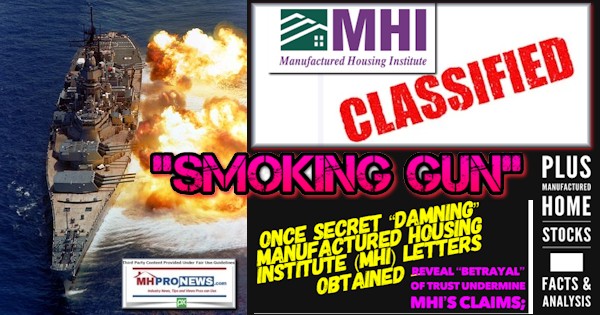
While every part of an article is clearly deemed significant by the source, or they wouldn’t have written it, perhaps one of the keen takeaways in what follows is this section of the news release: “…through a joint initiative by energy special interests and part of the industry to refer the development of those standards to a contrived “negotiated rulemaking” process. That sham process ultimately led to the 2016 DOE proposed standards, which MHARR vigorously and successfully opposed until they were withdrawn by the Trump Administration in January 2017.” Ponder that Manufactured Housing Association for Regulatory Reform (MHARR) statement in the light of the report and tip obtained reported exclusively by MHProNews, linked above. Note that their formal comments have well over 120 footnotes to buttress their statements.
This next pull quote is another example of a potent insight. In this case, it is from the MHARR comments portion of the report that follows: “DOE manufactured housing “energy conservation” standards, including the August 26, 2021 proposed standards, are – and always have been – a purported “solution” in search of a problem. Notwithstanding continual efforts by DOE, climate extremists, energy special interests and others to skew, manipulate, obfuscate and distort relevant data, the factual reality is that HUD-regulated manufactured homes, under existing HUD manufactured housing standards for energy and energy-related functions, already offer occupants lower monthly energy costs than other types of homes.”
Let’s tease this notion. This exercise is not about energy savings. Rather, it is about (mis)using regulators and special interest lobbies that often can be traced back to the “usual suspects” that play an oversized role in our profession to hobble competitors.
Full stop.
- That hobbling of competitors, some of whom would likely fail, in turn will make the affordable housing crisis worse.
- That will make the American Dream more remote for tens of millions.
- A few will benefit. The build to rent movement, which requires deep pockets or easy access to cost-effective capital, is well underway in manufactured housing. But meanwhile, more are forced into or will be trapped in rental housing. Conventional renting housing in many cases won’t be as energy efficient as a new manufactured home under current HUD standards.
With that backdrop, grab your favored beverage and take time to read what the Manufactured Housing Association for Regulatory Reform (MHARR) had to say in their latest press release. Then ask yourself this:
- why haven’t all others in manufactured housing trade media given this hot topic a similar level of clear reporting, analysis, and emphasis?
This MHARR news release will be followed by their actual comments letter and footnotes. That in turn will be buttressed by additional information and MHProNews commentary in brief. Finally, our business daily market reports and left-right headline summary will round out this article.

OCTOBER 25, 2021
IMPORTANT
TO: HUD CODE MANUFACTURED HOUSING INDUSTRY MEMBERS
FROM: MHARR
RE: DOE/ENERGY SPECIAL INTERESTS UNWITTINGLY SHOW THEIR HAND — INCREASING POTENTIAL FOR INDUSTRY LEGAL ACTION
Notwithstanding action by the U.S. Department of Energy (DOE) last week to grant a comment deadline extension as sought by MHARR, the Association, as previously announced, has today filed comprehensive written comments (attached) opposing the needless, destructive, high-cost “energy” regulations for manufactured housing proposed by DOE in an August 26, 2021 Supplemental Notice of Proposed Rulemaking (SNPR).
In addition, given the extension of the comment deadline to November 26, 2021 and the ongoing disclosure of new information concerning the DOE-proposed rule, the irretrievably-tainted rulemaking process that has led to this point and, more importantly, continues to fundamentally infect this entire proceeding, MHARR plans to continue its investigation of the origins of this matter, including the ongoing role of energy special interests, and will submit supplemental comments soon. Increasingly, though, evidence of the pattern of deception that has been established in this rulemaking underscores the potential need for legal action by the industry and consumers as well.
Most fundamentally, as was detailed with documentary evidence by MHARR in its comments addressing DOE’s initial June 17, 2016 proposed rule in this matter, manufactured housing energy standards – years overdue at that point – were essentially a dead letter at DOE, until they were resuscitated through a joint initiative by energy special interests and part of the industry to refer the development of those standards to a contrived “negotiated rulemaking” process. That sham process ultimately led to the 2016 DOE proposed standards, which MHARR vigorously and successfully opposed until they were withdrawn by the Trump Administration in January 2017.
Entirely new evidence, however, indicates that coordination and deception involving DOE and energy special interests continues to infect the core of this proceeding. First, DOE’s current round of activity was triggered by a Sierra Club lawsuit designed to compel the promulgation of manufactured housing energy standards by DOE and DOE’s acceptance of an agreed “consent order” in that case, to do just that.
Second, DOE’s August 26, 2021 proposed rule, unlike its 2016 proposal, contains “alternate” approaches – a so-called “tiered” approach with supposedly less costly standards for approximately 20% of the HUD Code market, designed to syphon-off as much opposition as possible, paired with an “alternate” non-tiered approach with much more costly standards for all manufactured homes based on the 2021 International Energy Conservation Code (IECC). The publication of such “alternate” proposals would allow DOE, in a final rule, to adopt either approach without engaging in another round of rulemaking, thus enabling a “bait and switch” scenario.
And that is precisely what new evidence is beginning to indicate, as DOE continues to act in apparent coordination with its energy special interest allies and those allies, in multiple comments already filed with DOE, have uniformly supported the adoption of the much more costly “untiered” manufactured housing standards, supposedly in order to avoid “discrimination” against purchasers of less costly “Tier 1” manufactured homes.
MHARR’s supplemental comments, accordingly, will analyze in depth — and will present supporting evidence detailing – this continuing coordination and deception, and its central role in the current rulemaking.
MHARR continues to encourage all industry members to submit their own comments opposing this destructive and discriminatory rule, which would undermine the fundamental affordability of manufactured housing while excluding millions of lower and moderate-income Americans from all of the benefits of homeownership. In the interim, MHARR will develop is further in-depth analysis of this matter and will make that analysis available to the industry in advance of the extended November 26 2021 comment deadline.
The industry and consumers, meanwhile, should begin to consider and weigh possible legal options, in the event that DOE ultimately adopts an unacceptable rule in this matter. ##
[Attachment]

October 25, 2021
VIA FEDERAL EXPRESS AND ELECTRONIC SUBMISSION
Hon. Jennifer Granholm
Secretary
U.S. Department of Energy
1000 Independence Avenue, S.W.
Washington, D.C. 20585-0121
Re: Energy Conservation Program: Energy Conservation Standards for
Manufactured Housing (EERE-2009-BT-BC-0021/RIN 1904-AC11)
Dear Secretary Granholm:
The following comments are submitted on behalf of the Manufactured Housing Association for Regulatory Reform (MHARR). MHARR is a Washington, D.C.-based national trade organization representing the views and interests of producers of manufactured housing regulated by the U.S. Department of Housing and Urban Development (HUD) pursuant to the National Manufactured Housing Construction and Safety Standards Act of 1974 (1974 Act), as amended by the Manufactured Housing Improvement Act of 2000 (2000 Reform Law).[1] MHARR was founded in 1985. Its members include independent manufactured housing producers from all regions of the United States.[2]
- INTRODUCTION
On August 26, 2021, the U.S. Department of Energy (DOE) published a Supplemental Notice of Proposed Rulemaking (SNPR) in the Federal Register, to establish “Energy Conservation Standards for Manufactured Housing” pursuant to section 413 of the Energy Independence and Security Act of 2007 (EISA).[3] EISA section 413,[4] in derogation of the comprehensive federal regulatory jurisdiction over manufactured housing[5] construction and safety delegated to HUD under the National Manufactured Housing Construction and Safety Standards Act of 1974, as amended, directs DOE to establish “energy efficiency” standards for manufactured housing “based on the most recent version of the International Energy Conservation Code (including supplements) except in cases in which the Secretary[6] finds that the code is not cost effective or that a more stringent standard would be more cost effective, based on the impact of the code on the purchase price of manufactured housing and on the total life-cycle construction and operating costs.” EISA further directs DOE to establish these standards pursuant to: (1) public notice and comment; and (2) “consultation with the Secretary of Housing and Urban Development, who may seek further counsel from the Manufactured Housing Consensus Committee” (MHCC) established pursuant to the Manufactured Housing Improvement Act of 2000.
For the reasons detailed below (and as set forth in previous MHARR comments submitted to both DOE and the MHCC,[7] which are incorporated by reference herein as if restated in full), MHARR strenuously opposes the tainted and destructive standards proposed by DOE in the August 26, 2021 SNPR as a baseless, extreme and ultimately useless burden on both moderate and lower-income consumers and the HUD Code manufactured housing industry including, most particularly, the industry’s smaller, independent businesses, that will inevitably lead to a further decrease in homeownership, higher levels of homelessness, and a further emasculation of free-market competition – with corresponding price increases – in a market already damaged by inflated raw materials prices and declining competition.
The August 26, 2021 DOE proposed rule ultimately,[8] is the product of a tortured, corrupted and fundamentally lawless ongoing regulatory process, dating back to and including DOE’s earliest administrative actions in this proceeding. That fundamentally lawless process, moreover, and the deceit, distortions, misrepresentations and cover-ups that have infected this proceeding from the outset, are a direct and foreseeable outgrowth of a “law” (i.e., EISA section 413) that itself, is not grounded in objective fact or reality, and is directly contrary to and in conflict with both pre-existing federal law and sound housing policy. As such, it essentially compels agency action that not only violates pre-existing federal manufactured housing law and is arbitrary and capricious in violation of the Administrative Procedure Act (APA) but is also fundamentally destructive for the housing-deprived lower and moderate-income American families, contrary to federal housing policy. Indeed, as MHARR documents below, the August 26, 2021 proposed rule would eliminate millions of American families from the heretofore affordable manufactured housing market and from homeownership altogether, insofar as manufactured housing is the nation’s most affordable source of non-subsidized homeownership.[9] The DOE proposed rule, meanwhile, would provide no benefits whatsoever to remaining manufactured homebuyers, given the fact that average manufactured housing energy costs for all fuel types tracked by the U.S. Census Bureau, are already lower than those for much more costly site-built homes, none of which are subject to the 2021 International Energy Conservation Code (IECC) which is the basis for the August 26, 2021 SNPR.[10]
Given these fundamental and inherent fatal defects, the DOE August 26, 2021 proposed rule, if adopted, would: (1) violate the “arbitrary, capricious [or] abuse of discretion” mandate of the APA;[11] (2) violate the 1974 Act, as amended; and (3) violate the EISA statute itself. Consequently, MHARR calls on DOE to rescind its August 26, 2021 proposed rule and pursue a legitimate rulemaking in this matter, based on the unique nature, construction and affordability of manufactured housing, using the pre-existing Federal Manufactured Housing Construction and Safety Standards (FMHCSS) and statutory HUD manufactured housing consensus process as the framework to develop such cost-effective manufactured housing energy standards as are objectively and legitimately warranted, rather than a baseless, ideology-driven “wish list” promoted by energy special interests and “climate” extremists. Absent such a fundamental change in approach by DOE and further proceedings that are fully consistent with all applicable law, all potential avenues for legal relief can and must remain an option for both the industry and consumers.
II. BACKGROUND AND PROCEDURAL HISTORY
The procedural history of this rulemaking can only be characterized as “grotesque.” While there has been no litigation yet concerning this matter, this entire proceeding – through and including its current iteration — is a paradigm, not only of government overreach into matters that are already fully and effectively addressed within the private sector,[12] but also fundamental lawlessness and abuse of power to advance an ideological agenda that will ultimately harm hard-working lower and moderate-income families, especially in the heartland of the United States, where the utilization of federally-regulated manufactured housing is most prevalent.[13]
While MHARR will not repeat verbatim the comprehensive recitation of the procedural and factual history of this rulemaking and docket leading to the current SNPR contained in its August 8, 2016 comments responding to DOE’s initial June 17, 2016 Notice of Proposed Rulemaking (NPR) concerning manufactured housing energy conservation standards (and incorporated by reference herein),[14] three points relating to that history bear further emphasis here, with regard to DOE’s August 26, 2021 SNPR.
First, while DOE asserts in its August 26, 2021 SNPR that its proposed two-tiered “primary” proposed standards and its “alternate” one-tier proposed standard – both premised on the 2021 IECC — “replace” its June 17, 2016 proposed standard,[15] the reality, as is evident from a thorough review of the August 26, 2021 SNPR and is, in fact, conceded at one point by DOE,[16] is that the standards proposed in the current SNPR are no more than a partial “update” of the 2016 NPR standards as initially proposed by DOE. And those 2016 NPR standards, in turn, as noted by DOE, were the product of the “negotiated rulemaking” initiated in this docket by DOE in 2014 and a 2015 “Term Sheet” ultimately recommended by DOE’s negotiated rulemaking “Manufactured Housing Working Group” (MHWG). By DOE’s own admission, therefore, the current SNPR and the “updated” proposed rule set forth therein, are inextricably related to — and a continuation and end product of – the 2014-2015 DOE “negotiated rulemaking” which, as fully-documented by MHARR in its August 8, 2016 written comments and attachments, was fundamentally corrupted and fatally-tainted in its conception, establishment, procedures, composition and recommendations. This admitted linkage, in itself, provides a sufficient basis for legal action in the event that the current proposed standard (either DOE’s “primary” proposal or “alternate” proposal) goes forward.
Second, insofar as the current proceeding and “supplemental” proposed rule represent a mere “update” of the June 2016 NPR proposed rule and its underlying process, rather than a complete break from the substance of – and process underlying – that fundamentally-tainted proceeding, all of the points and objections raised by MHARR in its August 8, 2016 comments concerning the 2016 NPR still apply and continue to fatally-infect this proceeding. Put differently, only an entirely new rulemaking, totally disconnected and divorced from any aspect of the sham DOE 2016 “negotiated rulemaking,” could establish the procedural and substantive separation and “distance” necessary to insulate further DOE administrative action under EISA section 413 from contamination and corruption by the fatally-defective 2016 process. And, insofar as that is manifestly not the case in this matter, the procedural history and corruption of the 2016 “negotiated rulemaking” are fully-relevant to this matter and (once again) fatally undermine this proceeding.
Third, that being the case, MHARR’s August 8, 2016 comments on DOE’s original NPR in this matter, show a consistent pattern of illicit coordination and manipulation of that proceeding by energy/climate special interests and other DOE-favored insiders to advance a proposed standard preferred by DOE. As is detailed with supporting documentation by MHARR’s August 8, 2016 NPR comments, those entities colluded with DOE to seek and obtain a truncated, meaningless, sham “negotiated rulemaking” process with a “minimum” number of meetings, in order to whitewash, cover-up, circumvent and avoid a directive to DOE by the Office of Management and Budget (OMB), to start-over work on a draft manufactured housing energy standards rule rejected by OMB because it had been “impermissibly” distributed to the very same special interests and insiders that had sought referral of manufactured housing standards to alleged “negotiated rulemaking.”[17] Instead of curing that taint, however, DOE resorted to further cover-ups and illicit coordination leading to the June 2016 NPR as documented by MHARR, and now, courtesy of a helpful lawsuit filed by a DOE special interest ally and an equally-convenient “consent” order entered in that litigation,[18] DOE, through the current SNPR, seeks to cement in place the ultimate product of that corrupted process.
That SNPR, however, which is the direct and linear result of a fundamentally-corrupted process, should be withdrawn by DOE. EISA section 413 requires the adoption of energy standards for manufactured housing. It does not require the adoption of fundamentally-tainted or corrupt standards or standards that, as further explained below, that would destroy the affordable manufactured housing market and deprive millions of lower and moderate-income Americans the substantial benefits of homeownership.[19]
III. COMMENTS
A. DOE’S PROPOSED STANDARDS ARE NOT COST-EFFECTIVE
OR APPROPRIATE FOR AFFORDABLE MANUFACTURED HOMES
1. MANUFACTURED HOME ENERGY USAGE AND COSTS
ARE ALREADY LOWER THAN OTHER TYPES OF HOMES
DOE manufactured housing “energy conservation” standards, including the August 26, 2021 proposed standards, are – and always have been – a purported “solution” in search of a problem. Notwithstanding continual efforts by DOE, climate extremists, energy special interests and others to skew, manipulate, obfuscate and distort relevant data, the factual reality is that HUD-regulated manufactured homes, under existing HUD manufactured housing standards for energy and energy-related functions, already offer occupants lower monthly energy costs than other types of homes. Indeed, federal government data shows that monthly manufactured housing energy costs have actually fallen further below energy costs for single-family detached site-built homes since DOE published its initial manufactured housing energy standards proposal in 2016.
In its written comments on the 2016 DOE manufactured housing energy rule, MHARR stated:
“As a consequence of … pre-existing HUD energy standards, manufactured homes, as established by U.S. Census Bureau data, are already energy efficient without regressive, high-cost DOE energy mandates. Specifically, data from the 2013 American Housing Survey shows that the median monthly housing cost for fuel oil was $92.00 for manufactured homes as compared to $267.00 for other types of housing. The median monthly cost for piped natural gas was $34.00 for manufactured homes as compared with $38.00 for other types of housing, and the median monthly cost for electricity was only slightly higher for manufactured homes (at $119.00) than other types of homes (at $105.00) – a difference of only $168.00 per year.”[20]
(Emphasis in original).
Newer data published in the 2019 American Housing Survey (AHS), however, shows that today’s modern, HUD Code manufactured homes, have lower median monthly energy costs than detached site-built homes in all fuel categories. Specifically, the 2019 AHS shows that the median monthly cost for fuel oil was $83.00 for manufactured homes, as compared with $125.00 for detached site-built homes.[21]The median monthly cost for natural gas was $40.00 for manufactured homes, as compared with $58.00 for site-built detached housing, and the median monthly cost for electricity was $122.00 for manufactured homes, as compared with $124.00 for site-built homes.[22] The median monthly fuel cost for HUD-regulated manufactured homes across all types and ages, therefore, is already up to 51% less than the monthly median fuel cost for single-family detached site-built homes.[23] Similarly, the mean monthly fuel cost for current manufactured homes, as calculated by the AHS, is also lower than the mean for single-family, detached, site-built homes with respect to monthly fuel costs. Thus, the mean monthly cost for electricity in manufactured homes is $133.00, as compared with $141.00 for detached, single-family, site-built homes, the mean monthly cost for piped gas in manufactured homes is $60.00, as compared with $73.00 for site-built homes, and the mean monthly cost for fuel oil is $88.00 in manufactured homes, as compared with $143.00 for site-built homes.[24] The mean monthly fuel cost for HUD-regulated manufactured homes across all types and all ages, therefore, is already up to 62% less than the mean monthly fuel cost for detached, single-family, site-built homes.[25]
The existing HUD manufactured housing energy standards, accordingly, ensure the energy operating affordability of manufactured homes – on a whole-home basis, as compared with site-built, single-family homes – while maintaining and preserving the overall purchase price affordability of manufactured housing in accordance with, and as required by, applicable federal law. By contrast, alleged “analyses” comparing site-built and manufactured home energy usage and energy costs on a per-square-foot basis, are irrelevant and misleading, because the average size of all manufactured homes in 2020 — again according to U.S. Census Bureau data – was 1,471 square feet, as contrasted with an average size of 2,527 square feet for a single-family site-built home, a size differential of almost 72%.[26] DOE, accordingly, should reject cost comparisons and analyses based on “per-square-foot” energy usage,[27] and should instead base its analyses and conclusions regarding the efficacy and affordability of manufactured housing energy standards on “whole house” energy usage and cost comparisons. Analyzed in that manner, using authoritative data from federal sources, it is apparent and, indeed, indisputable, that manufactured homes, under existing HUD Code energy standards, are already both energy-efficient and cost-efficient from the perspective of the homeowner as required by applicable federal law.
This result is also compelled by the fact that the cost-benefit language of EISA section 413, requiring that DOE manufactured housing energy standards be based on the most recent version of the IECC, “except in cases in which the Secretary finds that the code (sic) is not cost-effective” (emphasis added), must be construed and applied consistently with the purposes, objectives and requirements of existing law, in this case, the 1974 Act as amended by the 2000 reform law.[28] Therefore, the “cost-effective” proviso of EISA section 413 must be construed and applied – consistently with the 1974 Act, as amended – to ensure that non-life-safety DOE energy standards do not result in purchase price increases to manufactured homes that would significantly impair their affordability, availability and accessibility to all Americans, or otherwise decrease homeownership in violation of 42 U.S.C. 5401.
- THE PROPOSED STANDARDS WOULD RESULT
IN CATASTROPHIC PURCHASE PRICE INCREASES
The manufactured housing market — and manufactured housing regulation — is based on purchase price affordability. This statutory and regulatory focus on initial purchase price affordability is consistent with the status of manufactured housing as “the largest source of unsubsidized affordable housing in” the United States and an “important source” of low-income homeownership, as noted by the U.S. Consumer Financial Protection Bureau (CFPB).[29] Applicable law thus recognizes that manufactured housing is uniquely price-sensitive, as its consumer base is comprised largely of lower and moderate-income purchasers. Purchase price affordability, as a result, is necessarily antecedent to – and more critical to the manufactured housing market – than so-called “life-cycle” affordability, because for potential purchasers excluded from the market altogether by excessive, regulatory-driven purchase price increases, there is no home they can afford to purchase and, therefore axiomatically, no “life-cycle.” Accordingly, any cost-benefit analysis of the SNPR proposed rule, must focus first and foremost on its likely purchase price and purchase market impacts.
As currently constituted, the HUD manufactured housing construction and safety standards effectively maintain the purchase price affordability of manufactured homes at monthly energy operating cost levels (set forth above), that are well below the comparable monthly energy operating costs of site-built homes. Current HUD standards, moreover, also ensure that the total monthly operating costs of HUD Code manufactured are significantly lower than those of site-built homes. The 2019 American Housing Survey thus documented a monthly median housing operating cost of $610.00 for manufactured homes, and $1,106.00 for single-family, detached site-built homes, a savings of nearly 58% under the current HUD manufactured housing standards. Consequently, the existing HUD Code standards –including the existing HUD Code energy standards — are consistent with the affordability and affordability-balancing requirements of federal law, which ensure that manufactured homes are not only energy-efficient but are also available at a range of purchase prices that are affordable for lower and moderate-income Americans. The International Energy Conservation Code (IECC), by contrast, is subject to no similar statutory affordability or balancing mandates. As a result, it is a high-cost code, as was demonstrated initially by MHARR in 2016 with respect to the 2015 IECC and subsequently by Home Innovation Research Labs (HIRL) – the research arm of the National Association of Home Builders (NAHB)[30] – with respect to the 2021 IECC.
The 2015 IECC, which was the basis for DOE manufactured housing energy standards initially proposed in 2016[31]— as calculated by MHARR – would have resulted in retail level purchase price increases of $4,601.00 for a single-section manufactured home, and $5,825.00 for a double-section manufactured home.[32] These amounts included industry-standard builder and retailer profit margins,[33] but did not include regulatory testing, compliance or enforcement costs, which were not estimated or considered by DOE in the June 2016 rulemaking proceeding. Consistent with these MHARR’s 2016 findings, a June 2021 HIRL report now shows that the 2021 IECC, as published, would result in a national incremental construction cost increase of $6,548.00 to $9,301.00 for a specified reference home of 2,500 square feet, depending on the compliance mechanism selected.[34] The same analysis shows a national simple construction cost payback period ranging from 32 to 67 years, again based on the compliance mechanism. Prorating these amounts to the smaller size of an “average” single-section and double-section manufactured home, as defined by the U.S. Census Bureau, and including industry-standard profit margins identical to those used in MHARR’s 2016 calculation, the 2021 IECC, in unmodified form, would yield a minimum incremental retail-level price increase of $7,958.00 for an “average” single section manufactured home and a minimum incremental retail-level price increase of $12,908.00 for an “average” double-section manufactured home.[35] Moreover, as large as these amounts are, they are necessarily incomplete, in that: (1) they do not include regulatory testing, compliance or enforcement costs; and (2) do not include costs attributable to future changes to the IECC and the costs of compliance with such future modifications – which are, and would be, totally unnecessary for today’s modern, already energy cost-efficient, HUD Code manufactured homes.
While the August 26, 2021 DOE proposed rule does not incorporate the full 2021 IECC as to either “Tier1” or “Tier 2,” and also includes arbitrary DOE modifications to certain 2021 IECC criteria (see, relevant sections, below), MHARR expects that a full purchase price analysis of the DOE proposal, based on current costs for smaller, independent producers, will yield expected purchase price increases between the 2016 MHARR projected amounts and the 2021 HIRL projected amounts. Regardless of the precise amount(s), however, price increases of this magnitude – and anywhere within this potential range — within the highly price-sensitive manufactured housing market, would be devastating to lower and moderate-income consumers who rely on the purchase price affordability of manufactured housing, in violation of applicable federal law.
First, price increases of this magnitude would exclude millions of Americans from the manufactured housing market and from homeownership altogether. An NAHB analysis presented to the DOE Manufactured Housing Working Group in 2014, demonstrated that for every $1,000.00 increase in the purchase price of a single-section manufactured home, 347,901 households are excluded from the market. Similarly, for a double-section home, a $1,000.00 purchase price increase excludes 315,385 households from the market.[36]Extrapolating these amounts to the purchase price increases under the full, unmodified 2021 IECC calculated above, 2,748,417 households would be excluded from the single-section manufactured housing market (and homeownership altogether) and 4,068,466 households would be excluded from the double-section manufactured housing market.[37]In total, therefore, 6,816,883 households that could afford to purchase a manufactured home now, would be totally excluded from the market under the 2021 IECC. At a 2020 annual production level of 94,390 total homes, this degree of consumer exclusion represents a loss of more than 72 years of manufactured home production. Furthermore, for those excluded from the market altogether due to 2021 IECC-driven price increases, by definition, there would be no “life-cycle” savings whatsoever, and no payback period of any kind.
Extrapolating the same analysis to a median purchase price increase level 50% above that calculated by MHARR for the 2016 IECC, and 50% below the unmodified 2021 IECC to reflect the potential impact of DOE SNPR modifications, the corresponding purchase price increase levels would be $6,279.00 for a single-section manufactured home and $9,366.00 for a double-section manufactured home. At these amounts, more than 2,156,986 households would be excluded from the HUD Code single-section market, and more than 2,933,080 households would be excluded from the HUD Code double-section market, for a total of over 5,090,006 households, representing nearly 54 years of production at 2020 market levels.
Even with substantial modifications to the 2021 IECC, therefore, the impact of the DOE proposed rule on the manufactured housing market, manufactured housing consumers, and manufactured housing producers, retailers and communities, including most especially smaller businesses operating at lower profit margins, would be extreme and extremely destructive. Insofar as it would decimate the affordable manufactured housing market, it should and indeed, must be rejected.[38]
Second, and in addition to this excessive and disproportionate level of total market exclusion that would result from the DOE proposed rule – leading to higher levels of homelessness among lower and moderate-income families — cost increases of this magnitude would substantially reduce the number of lower and moderate-income purchasers who could qualify to finance a manufactured home purchase. Already, at current retail price levels, the vast majority of applications for manufactured home consumer purchase loans are denied. According to a May 2021 report by the U.S. Consumer Financial Protection Bureau (CFPB),[39] only “a minority (27 percent) of consumers who applied for a loan to buy a manufactured home succeeded in obtaining financing.[40] Of those who did not obtain financing, the majority were denied…. An estimated 42 percent of all manufactured home purchase applications were denied, including 50 percent of chattel [loan] applications…. In comparison, only 7 percent of site-built [loan] applications were denied.”[41](Emphasis added). By increasing purchase price levels and corresponding cost burdens for consumers potentially remaining in the market, the number of potential manufactured housing purchasers who could qualify for consumer financing would be reduced even further, and the affordability of manufactured housing in relation to site-built and other types of housing would disappear, again in violation of existing and applicable law.
Furthermore, as the May 2021 CFPB Report emphasizes, the higher level of rejection rates within the chattel or personal property manufactured housing purchase loan sector – which will be significantly exacerbated by the proposed DOE energy standards – will disproportionately impact and harm “Hispanic white, Black and African American and American Indian and Alaska Native borrowers” who make up larger shares of [manufactured home] chattel borrowers than among … site-built loan borrowers.”[42]”This will especially be the case for “Black and African American borrowers,” who are “overrepresented in [manufactured home] chattel lending compared to site-built” home lending.[43]Such a flagrantly discriminatory policy with indisputable racially-disproportionate impacts, would directly contravene the racial equity policies of President Biden as are reflected in the Administration’s January 26, 2021 “Memorandum on Redressing our Nation’s and the Federal Government’s History of Discriminatory Housing Practices and Policies.”[44]That Memorandum states, in relevant part: “During the 20th century, Federal, State and local governments systematically implemented racially discriminatory housing policies that contributed to segregated neighborhoods and inhibited equal opportunity and the chance to build wealth for Black, Latino, Asian American and Pacific Islander and Native American families…. Accordingly, it is the policy of my Administration that the federal government shall work with communities to and housing discrimination [and] to eliminate racial bias and other forms of discrimination in all stages of home-buying….”[45]
On cost grounds alone, therefore, the IECC, modified or unmodified, is not an appropriate or legitimate code for affordable manufactured homes and cannot be made into an appropriate or legitimate code for manufactured homes through arbitrary and haphazard “modifications.” Furthermore, the IECC has been developed – including in its 2021 iteration – pursuant to a voting system that gave final authority over its provisions to state and local building code officials who are not responsible for the development of manufactured housing standards and have not been responsible for such standards since the enactment of the first federal manufactured housing standards law, nearly 50 years ago. Accordingly, the IECC is fundamentally and organically not an appropriate code for manufactured housing and cannot be transformed into one or shoehorned by DOE through changes and modifications around its periphery. Rather, the only appropriate code for manufactured housing is the HUD Code, subject to all applicable law governing its substance and development procedures.
- DOE’S “TIER ONE” STANDARDS WOULD AFFECT ONLY
A FRACTION OF THE MANUFACTURED HOUSING MARKET
DOE, in its August 26, 2021 SNPR, attempts to paper-over these damning purchase price impacts by – at least for now — bifurcating its proposed standard into two separate “tiers.” As explained by DOE, “under the tiered proposal, two sets of standards would be established…. Tier 1 would apply to manufactured homes with a manufacturer’s retail list price of $55,000.00 or less,”[46] applying allegedly less costly and more highly-modified 2021 IECC measures to such homes. Tier 2 “would apply to manufactured homes with a manufacturer’s retail list price above $55,000.00”[47] and incorporate a broader range of more costly 2021 IECC measures. Significantly, though, DOE’s August 26, 2021 SNPR includes, as an “alternative proposal,” an “’untiered’ approach, wherein energy conservation standards for all manufactured homes would be based only on the 2021 IECC.”[48]Put differently, this means that despite the talk of a “tiered” system, and the use of a tiered proposal to potentially lure stakeholders, HUD and the public into supporting the 2021 SNPR, a final rule in this matter could ultimately have no separate cost-based “tiers” at all, and subject all manufactured homes to high-cost market-crushing IECC-based energy standards. For this reason alone, MHARR strenuously opposes the August 26, 2021 DOE proposed rule. But even assuming that the “tiered” proposal is not a tactical deception that will ultimately be withdrawn and discarded, the August 26, 2021 proposed standard would still result in grievous harm to the manufactured housing market, manufactured housing consumers and the manufactured housing industry, with disproportionately destructive impacts on smaller industry producers, retailers, communities and other smaller businesses.
First, the selection of a retail list price of $55,000.00 as the demarcation line between the “Tier1” proposed standards and the much harsher and more costly “Tier 2” standards is arbitrary and capricious,[49] and would subject the overwhelming majority of all manufactured homes to the “Tier 2” standards in any event. The most recent U.S. Census Bureau data for manufactured housing, found that the “average” sales price of a single-section manufactured home in 2020, was $57,300.00.[50]Meanwhile, the “average” price of a double-section manufactured home was $108,500.00 and the “average” price of all manufactured homes was $87,000.00.[51]With material costs having increased in 2021, moreover, these amounts are likely substantially higher today. The $55,000.00 demarcation line, accordingly, was in 2020 – and is in 2021 — less than the average price of a single-section manufactured home. Single-section homes, in turn, comprise less than 45% of the total HUD Code manufactured housing market. The overwhelming majority of the HUD Code market in 2021, therefore, is comprised of homes priced in excess of $55,000.00. As a result, the more costly and burdensome “Tier 2” standards will impact the overwhelming majority of manufactured homes and manufactured housing consumers, with the devastating market consequences detailed above. Accordingly, the “two-tiered” system proposed by DOE – ostensibly to address the devastating market consequences of harsh IECC standards, even as modified by DOE – will have no such ameliorative impact. (See also, further discussion of this topic, supra).
Second, and as noted above, at current price levels, only “27 percent of consumers who applied for a loan to buy a manufactured home succeeded in obtaining financing” according to CFPB. This means, conversely, that among households actually seeking to purchase a manufactured home, some 73% of prospective purchasers were denied financing and, presumably, were unable to purchase a HUD Code home (or any home). Insofar, then as the 94,390 HUD Code homes actually purchased in 2020 represent just 27% of the 349,592 homes that potentially could have been purchased in 2020 if all such loan applications had been approved, the 73% of potential manufactured homebuyers rejected for purchase-money financing, represent additional potential sales of 255,202 homes[52]— which were not manufactured and sold in 2020 because of the unavailability of financing for lower and moderate-income consumers at those existing price levels. Obviously, then, if manufactured home purchase price levels are substantially increased by punitive and discriminatory DOE energy standards, the approval rate for HUD Code home loans (with all other factors being held equal) would fall even further, thereby further depressing sales and utilization levels that continue to run far below historic norms.[53]
Nor do any of these cost calculations even begin to consider the likely impact of future IECC code changes. Insofar as EISA section 413 mandates continuing IECC-based standards updates, and the IECC is currently updated on a three-year schedule, future updates will require further modifications of the DOE standards which, in turn, will require engineering updates and related HUD enforcement system approvals for manufacturers, all of which will entail substantial additional costs and even further destructive market disruptions – none of which has been or will be captured by DOE’s alleged regulatory cost analysis.
Again, therefore, the regulatory structure and standards envisioned by DOE would be destructive of the manufactured housing market and would undermine the fundamental affordability of manufactured housing in violation of existing federal law, with its worst impacts and consequences affecting the lower and moderate-income American families who rely the most on the purchase price affordability of mainstream HUD Code manufactured housing.
- THE IECC IS NOT AN APPROPRIATE CODE
FOR AFFORDABLE MANUFACTURED HOUSING
The IECC, as acknowledged by DOE,[54] is not and never has been a code for manufactured homes. Whereas the Federal Manufactured Housing Construction and Safety Standards (FMHCSS) and FMHCSS energy standards developed and maintained by the U.S. Department of Housing and Urban Development (HUD) are specifically tailored to the unique size, affordability and construction imperatives of manufactured homes based on a balance between homeowner protection and affordability expressly mandated by federal law,[55] the IECC standards are not now – and never have been – developed for manufactured homes or the affordability needs of actual and potential manufactured home consumers. Nor have they ever been developed, voted-on, or approved (including in their 2021 iteration) by individuals with a direct knowledge of either manufactured housing or the unique construction and affordability challenges required to comply with federal manufactured housing law. The IECC, accordingly, is fundamentally contrary to applicable federal manufactured housing law and cannot be transformed into an appropriate code for affordable manufactured homes through arbitrary, piecemeal DOE modifications.
Because the IECC is not developed based on the specific construction and affordability aspects of manufactured housing, the IECC would devastate the affordable manufactured housing market. As is detailed above, the 2015 IECC — the basis for DOE manufactured housing energy standards initially proposed in 2016 — would have resulted in retail level purchase price increases of $4,601.00 for a single-section manufactured home, and $5,825.00 for a double-section manufactured home as calculated by MHARR.[56]These amounts included industry-standard builder and retailer profit margins,[57]but did not include regulatory testing, compliance or enforcement costs, which were not estimated or considered by DOE in its June 2016 proposed rule. Consistent with these findings, a Home Innovation Research Labs analysis[58]has concluded that the 2021 IECC, as published, would result in an incremental construction cost increase of $6,548.00 to $9,301.00 for a specified 2,500 square foot site-built reference home (depending on compliance mechanism).[59]Prorated to the smaller size of an “average” manufactured home and including industry-standard profit margins identical to those used in MHARR’s 2016 calculation, the 2021 IECC, in unmodified form, would yield a minimum incremental retail-level price increase of $7,958.00 for an “average” single section manufactured home and a minimum incremental retail-level price increase of $12,908.00 for an “average” double-section manufactured home.[60]These amounts, though, are necessarily partial and incomplete, in that: (1) they do not include regulatory testing, compliance or enforcement costs; and (2) do not include costs attributable to future changes to the IECC and the costs of compliance with such future modifications.
The fundamental incompatibility between the IECC and standards that would be appropriate for HUD Code manufactured housing is due, in part, to the absence of a statutory purchase price affordability mandate for the IECC,[61] comparable to the 1974 Act as amended by the 2000 reform law. It is also due, however, to the nature and composition of the IECC committee and the IECC development process, through and including the 2021 IECC. Specifically – and unlike FMHCSS standards under the 2000 reform law — all iterations of the IECC through the 2021 version, were subject to a “governmental consensus” process, in which local government building code officials with no responsibility for the regulation of manufactured housing and no sensitivity to the affordability concerns implicated by extreme price increases, were exclusively empowered to consider and approve the final standards.[62] Indeed, there is no evidence or indication that the IECC committee – through its 2021 iteration — has ever had any members representing manufactured housing producers or stakeholders with specific knowledge of the industry, its homes, its consumers, its market characteristics, or the consumer financing of its homes. This stands in sharp contrast with the MHCC process, where proposed standards are considered and recommended by a congressionally-mandated consensus committee, with members “qualified by background and experience to participate in the work” of the Committee (emphasis added),[63]representing all relevant categories of stakeholders.
The National Association of Home Builders (NAHB), moreover, has demonstrated that this “governmental consensus” process was “manipulated” and “abused” by energy special interests during the most recent revision cycle, including the final 2021 IECC relied-upon by DOE in its August 26, 2021 SNPR. While this charge has led to significant changes in the IECC process for the 2024 cycle, those changes do not cure or ameliorate the fatal flaws that make the IECC inappropriate and unacceptable as a basis for any manufactured housing energy standards.
Specifically, the 2021 IECC revision process saw multiple high-cost proposals previously rejected by IECC committees, reinstated and adopted, during the final government-official-only vote, after behind-the-scenes activity by energy special interests to lobby and pressure government officials to cast votes in favor of those previously-rejected proposals. A site-builder group, Leading Builders of America (LBA), explained this “manipulation” of the IECC process in a January 26, 2021 communication, stating: “For the building community, the 2021 [IECC] update is a cause for serious concern. Multiple code changes were approved that will increase the cost of a new home by up to $10,000 with only modest savings for consumers. Some of the new requirements have payback periods over 100 years. Each of these ‘high-cost-low-benefit’ code changes were twice rejected during the code development process. They were approved as a result of an unprecedented effort to manipulate the ICC’s governmental online consensus vote.” (Emphasis added). To support these claims, LBA provided recordings of conference calls with special interest activists lobbying government official voters to follow a “voting guide” showing the previously-rejected proposals the activists sought to have reinstated in the final IECC vote.
As a result of this “political manipulation,” the ICC Board of Directors, in March 2021, voted to convert the IECC from a government code process to an American National Standards Institute (ANSI)-based consensus process. Under the Board’s decision, however, this change will not become effective until the 2024 revision process begins. And even though the 2024 (and beyond) process will change because of the special interest “manipulation” implicitly confirmed through the decision of ICC Board, the Board incongruously decided to keep in place not only the “politically manipulated” and thus tainted 2021 revisions adopted through the “government only” system then in place, but all of the IECC provisions previously approved through that same tainted and flawed system. The Executive Summary of the ICC Board’s decision thus states: “The 2024 IECC will start from the content of the 2021 IECC.” (Emphasis added).[64]While thus effectively acknowledging the validity of the claims of a fundamentally-tainted IECC 2021 process, the ICC decision will leave the results of that tainted process in place as a springboard to further contaminate future IECC revisions that would build upon a fundamentally-tainted “foundation.”
The ICC Board’s decision concerning the nature of the IECC is relevant to the August 26, 2021 DOE proposed rule in that it affirmatively confirms that the IECC, through the 2021 iteration specifically utilized and relied-upon by DOE, was: (1) not only approved in its final form by land use officials with no background whatsoever in manufactured housing; but (2) that it was developed and approved through a process that was “abused” and “manipulated” to impose measures that are excessively-costly and produce no positive results for consumers over a normal homeownership tenure period. Consequently and particularly in light of the extreme purchase price impacts documented by the HIRL report, it is not – and should not be — surprising that the 2021 IECC, to date, has not been adopted for site-built or modular homes by any jurisdiction in the United States.[65]More importantly, though, such a code, that since its inception has been under the exclusive control of state and/or local governments officials that: (1) exclude or otherwise discriminate against manufactured homes and manufactured homebuyers;[66] and (2) have no direct experience, knowledge, or expertise regarding manufactured home construction or regulation — is not now, never has been, and never could be a proper or legitimate basis for manufactured housing energy standards.
Moreover, even after the IECC process changes for the 2024 revision cycle, the IECC would remain a fundamentally unsuitable and unacceptable code for supposedly “affordable” manufactured housing. First, there continues to be no purchase price affordability mandate for IECC standards comparable to that contained in the 1974 Act as amended. Second, an official statement published by the ICC Board states that local building officials with no involvement whatsoever with any other aspect of manufactured housing regulation – and often opponents of equitable zoning and placement for manufactured homes – “will continue to have a leading voice” in the IECC development process.[67]Third, ICC appointments to the 2024 IECC residential committee exclude any representatives of smaller, independent manufactured housing producers or businesses, but do include representatives of “climate change” special interest groups with no conceivable knowledge of manufactured housing, its construction, its consumers, or its market.[68] Fourth, the same official ICC statement makes it clear that the focus and primary purpose of the IECC is related to the supposed effects of “climate change,” not to ensuring the availability of affordable housing and combating the devastating economic and societal impacts of homelessness or housing insecurity. The ICC Board statement thus asserts, in relevant part: “The Code Council will build on the technical solutions provided by the International energy Conservation Code … to create a portfolio of advanced mitigation solutions to battle the impacts of our changing climate. This portfolio will provide a menu of options for jurisdictions, from a strong and increasing set of minimum requirements, to pathways to net zero energy and additional greenhouse gas reduction policies.”[69]The IECC’s purposes, objectives and processes, consequently, are in conflict with and violate the affordable housing and housing availability requirements and policies of pre-existing federal manufactured housing law.
Accordingly, DOE’s August 26, 2021 proposed manufactured housing energy standards are based on a 2021 IECC that is not designed or intended for manufactured homes, was approved by building code officials with no authority over manufactured housing regulation, conflicts with and undermines the fundamental affordability of manufactured housing and is, in no way, appropriate for manufactured homes designated as affordable housing by federal law. Consequently, DOE’s August 26, 2021 SNPR should be withdrawn.
B. DOE’S COST “ANALYSIS” IS MISLEADING AS IT FAILS
TO REFLECT THE FULL COST OF THE PROPOSED RULE
DOE’s August 26, 2021 SNPR contains an alleged cost-benefit analysis of its proposed manufactured housing energy conservation rule. That supposed analysis, however – which is affirmatively required by both EISA and the 1974 Act, as amended – is flawed, incomplete and misleading for multiple reasons, as explained in the following sections. And because that statutorily-required cost-benefit analysis is flawed, incomplete and misleading, the DOE August 26, 2021 proposed rule: (1) violates the substantive mandate of EISA section 413 and section 604(e)(4) of the 1974 Act as amended; but is also (2) “arbitrary, capricious and not in accordance with law” in violation of the Administrative Procedure Act.[70] As a result of this inherent, fatal and fundamental defect in the August 26, 2021 proposed rule, the proposed rule should be withdrawn.
- DOE’S COST CALCULATIONS ARE
MATERIALLY FALSE AND DEFECTIVE
As an initial matter, it should be noted that the cost-benefit “analysis” offered by DOE in support of its now supposedly-withdrawn 2016 proposed rule,[71] was materially false and defective, as is the cost-benefit analysis for the 2021 DOE proposed rule. DOE, for example, maintained in its June 17, 2016 Notice of Proposed Rulemaking that its proposed standards would add up to $2,422 to the retail price of a single-section manufactured home (with a national average of $2,226) and up to $3,748 to the cost of a new multi-section manufactured home (with a national average of $3,109).[72] In reality, however, as calculated by MHARR, the 2016 DOE proposed manufactured housing energy standards would have added a minimum $4,601.00 to the retail price of a new single-section manufactured home,[73] and a minimum of $5,825.00 to the cost of a double-section manufactured home. Consequently, the actual purchase price cost-impact of DOE’s 2016 proposed rule would have been 90% higher than DOE’s estimate for single-section manufactured homes, and 55% higher than DOE’s partial estimate for double-section homes.
Significantly, the same material flaw is now incorporated within DOE’s 2021 proposed rule. Thus, according to DOE, its “Tier 2” IECC-2021-based standards would result in a national average $3,914.00 price increase for single-section manufactured homes (again, excluding likely significant costs related to enforcement, testing and regulatory compliance) and a $5,289.00 price increase for double-section manufactured homes. As calculated by HIRL, however, the prorated purchase price impact of the unmodified 2021 IECC, would be $7,958.00 for a single-section manufactured home and $12,928.00 for a double-section home – a full 103% and 144% higher than DOE’s 2021 estimate. Even if the HIRL figures were reduced to correspond to the same differentials illustrated by the 2016 data however (i.e., actual cost impacts 90% higher than DOE-estimated for single-section homes and 55% higher for double-section homes) in order to account for the potential impacts of DOE modifications to the 2021 IECC in the August 26, 2021 proposed rule, the resulting purchase price increases would still be devastating for the affordability-based manufactured housing market, with a $7,436.00 average retail price increase for single-section homes and a $8,197.00 average retail price increase for double-section manufactured homes. These higher amounts, moreover, under DOE’s own analysis, would impact at least 75% of all manufactured homes produced annually under DOE’s “tiered” approach and, obviously, 100% of all manufactured homes under the un-tiered, “Tier 2-only” approach.[74]
- DOE’S COST ANALYSIS FAILS TO CONSIDER
ONGOING REGULATORY COMPLIANCE COSTS
DOE’s August 26, 2021 SNPR asserts that proposed manufactured housing energy conservation standards will result in net “life-cycle” operating cost savings to manufactured housing purchasers that would offset and exceed projected purchase price increases attributable to the proposed standards.[75]The findings of DOE’s cost analysis are necessarily flawed, skewed and materially inaccurate, however, in that they do not reflect, consider or account for key cost components and information. As a result, the claimed benefits of the proposed rule are netted against incomplete and/or inaccurate cost data, thereby yielding alleged “payback” amounts and timeframes that are distorted and biased in favor of the proposed rule. This distortion has several distinct aspects, which are addressed in the sections, below.
Most significantly, the DOE cost-benefit analysis fails to include or consider significant additional costs that will be incurred by manufacturers – and inevitably passed to consumers in the purchase price of new manufactured homes – for: (1) testing, certification, inspections and other related activities to ensure compliance with any new DOE standards; (2) enforcement compliance and activity; and (3) ongoing regulatory compliance. Although such expenses are – and are recognized as — an integral component of the ultimate consumer-level cost of any mandatory rule,[76] they are totally excluded from DOE’s cost-benefit and life-cycle cost (LCC) analyses in this rulemaking.[77]Those analyses, as a result, are skewed toward greater alleged benefits from the proposed rule and shorter consumer LCC “payback” times than would be the case if all applicable costs were included and considered. Indeed, as it stands now, under DOE’s fundamentally flawed and incomplete LCC analysis, the projected consumer “payback” period – i.e. 10.9 years for a single-section home and 10.6 years for a multi-section home under “Tier 2”[78] — is already longer than many consumers will live in a new manufactured home.[79]The addition of testing, enforcement and regulatory compliance costs (and other additional uncaptured costs set forth below), would extend that payback period even longer, meaning that even fewer homebuyers (i.e., those not excluded from the market altogether due to prohibitive purchase price increases attributable to the proposed rule) will ever recapture purchase price increases necessitated by the proposed rule.
This deceitful bifurcation of direct standards-generated costs on the one hand and testing, enforcement and regulatory compliance costs on the other – notwithstanding the fact that all such costs, as well as further costs for compliance with existing HUD Procedural and Enforcement Regulations,[80] will represent additional consumer-level costs under any final DOE rule – began during the fundamentally-tainted, sham “negotiated rulemaking” process, where DOE, via its “Designated Federal Official,” barred discussion or consideration of any aspect of enforcement or regulatory compliance, or their associated costs. The absurd and misleading bifurcation was continued in DOE’s initial June 17, 2016 NPR,[81] and is now incorporated in the 2021 SNPR.[82] The intentional omission of such cost data, however, represents an admission by DOE that its cost-benefit analysis and LCC “calculations” are necessarily inaccurate, incomplete and not reflective of the true and complete costs of the proposed rule.
DOE’s consumer-level cost-benefit analysis, therefore, compares “apples to oranges,” netting out all conceivable “savings” against only part of the costs that will be added to the price of the home. As a result, there is no basis, whatsoever, for DOE to conclude – in connection with this rule — that consumer benefits exceed costs, because the full costs of the proposed standards are not known and cannot be known until DOE, at a minimum, settles on a compliance and enforcement system, which – it admits – has not occurred. Nor can a cost-recovery period be accurately calculated because all relevant and applicable costs — again – are not known and not fully quantified as of now and cannot even be accurately estimated with so many unknowns. Indeed, the attempt to pass-off this fundamentally-incomplete recitation as any kind of legitimate cost-benefit analysis, is itself disingenuous. Therefore, DOE’s analyses are neither credible nor legitimate and, per se, cannot be – and are not – sufficient to satisfy the substantive cost-benefit directive of EISA section 413, the 1974 Act as amended, or the “arbitrary, capricious or abuse of discretion” standard of the APA.
- DOE’S COST “ANALYSIS” FAILS TO CONSIDER
THE IMPACT OF SUBSEQUENT IECC CHANGES
By requiring DOE to constantly update manufactured housing standards to keep pace with the “latest version” of the IECC, which is revised every three years without regard to cost-benefit, EISA not only discriminates against manufactured homebuyers vis-à-vis other types of homes regulated under earlier, less stringent and less costly versions of the IECC,[83] but also adds an element of ongoing regulatory uncertainty that will further increase manufacturer compliance costs and the cost of manufactured homes to consumers that are not captured within DOE’s SNPR cost-benefit analysis.
The significant negative impact of ongoing regulatory uncertainty within regulated industries – and, in particular, on regulated industry participants, such as manufactured housing producers – has been addressed extensively by economists, with studies showing that regulatory uncertainty has a pronounced negative impact on investment, growth, and competitiveness, resulting in both consumer, industry and national-level costs that are not addressed, considered or reflected in DOE’s cost-benefit analysis.[84]
These negative impacts will not only increase the cost of manufactured housing beyond the amounts projected by DOE – thereby extending DOE-estimated LCC cost-payback timeframes that already exceed the period that significant numbers of manufactured homeowners will remain in their homes – but they will also: (1) increase the numbers of lower and moderate-income Americans excluded from the manufactured housing market and homeownership altogether; and (2) reduce the availability of affordable manufactured housing, contrary to the mandate and purposes of existing federal manufactured housing law. The failure to consider such ongoing impacts further demonstrates that DOE’s proposed action is arbitrary, capricious, an abuse of discretion, and not otherwise in accordance with applicable law.
- DOE FAILS TO CONSIDER DISPROPORTIONATE
IMPACTS ON SMALLER INDUSTRY BUSINESSES
While DOE acknowledges that its proposed rule would have a significant negative impact on the manufactured housing industry – an industry that has seen production contract by 75% since 1998,[85] with corresponding reductions in the number of producers – its cost analysis fails to fully or properly quantify the likely anti-competitive effects of its proposed rule and the resulting highly-negative impacts on industry small businesses and consumers.
DOE alleges in its August 26, 2021 SNPR that its proposed two-tier proposed rule would result in a decline in “industry net present value” of $276 million to $325 million, while its un-tiered so-called “alternative” proposal would result in a reduction of $340 million to 390 million.[86] This “calculation,” however, using a government “regulatory impact” model with data inputs provided by DOE,[87]would necessarily be skewed significantly lower by DOE’s reliance on unrealistically low IECC regulatory cost impacts — as demonstrated above — as well as by DOE’s failure to include significant additional regulatory cost elements (i.e., enforcement, testing and regulatory compliance costs and the costs of constantly more stringent IECC standards, as detailed above) in its SNPR cost analysis. Thus, for example, DOE’s purchase price impact data under “Tier 2” indicates a consumer level “national” price increase of $3,914.00 for a single-section home and $5,289.00 for a double-section home. These amounts, however, are respectively some 90% and 55% lower than the modified-case IECC 2021 cost increases (i.e., $7,436.00 and $8,197.00) estimated by MHARR based on the above-described HIRL IECC 2021 cost analysis. Based, again, on the NAHB market exclusion data, purchase price increases of this magnitude would exclude millions more potential purchasers than would have been considered by DOE under its GRIM model. Again, therefore, that model would necessarily significantly underestimate the total impact on manufactured housing industry businesses and, more specifically, the disproportionately negative impact that those cost increases would have on smaller industry businesses.[88]
Over time, moreover, such disproportionate price impacts will result in further consolidation within an industry that – since its major production decline began in 1998 — has already seen a substantial reduction in the number of producing companies and an emerging concentration of the manufactured housing market in the hands of a few large corporate conglomerates.[89]Again, though, DOE’s cost-benefit analysis fails to address, consider or account-for these negative impacts – and their related costs — on consumers, the industry and the nation as a whole. This type of extreme negative economic and societal impact was correctly explained in comments previously submitted to DOE by the Mercatus Center of The George Mason University: “[T]his regulation will disproportionately burden small businesses and benefit large manufacturers. This regulation will become an income transfer scheme as small businesses go out of business competing with large manufacturers, giving large manufacturers access to a larger consumer base and increasing their income. This is an income transfer scheme that will produce unintended consequences, including causing an industry to be dominated by a few large firms.” And, in fact, specific evidence presented by MHARR in its comments on the DOE 2016 proposed manufactured housing energy rule, detailed apparent coordination by DOE with larger conglomerates regarding more stringent energy standards.[90]
DOE’s August 26, 2021 SNPR, however, fails to – and, in fact, refuses — to address this disproportionate impact issue and its collateral effects on competition, industry consolidation and consumer prices, stating: “Section 413 of EISA does not require consultation with the [Department of Justice] regarding potential anti-competitive effects of a rule, as would be required for an appliance standard rulemaking. As such, DOE did not consult with DOJ regarding potential anticompetitive impacts of the proposed rule.”[91]This statement, however, conveniently mischaracterizes the issue raised by the expected disproportionate impact of the DOE proposed rule. That issue is not the proposed rule’s “anticompetitive impact,” per se, but rather, its ultimate impact on consumer prices within the manufactured housing market, which are rising, and would rise even further – and more rapidly as a matter of basic economics – with a smaller number of independent manufacturers.
Insofar as none of these significant cost impacts and factors are considered by DOE in the cost analysis for the August 26, 2021 proposed rule, that rule is fatally deficient, unsupported by proper and sufficient evidence, and legally unsustainable. Moreover, insofar as DOE has the “affirmative burden of promulgating and explaining a non-arbitrary, non-capricious rule,”[92] DOE’s failure to fully and accurately quantify the effect of its proposed rule on small industry manufacturers is, per se, a fatal defect that should invalidate the August 26, 2021 proposed rule.
C. THE $55,000 DEMARCATION BETWEEN DOE’S PROPOSED
“TWO-TIER” STANDARDS IS ARBITRARY AND CAPRICIOUS
DOE’s proposed “two-tier” energy standards system is based on a manufacturer’s retail list price dividing line between the two tiers, with “Tier 1” comprising homes with a manufacturer’s retail list price up to $55,000.00 and “Tier 2” comprised of manufactured homes with a manufacturer’s retail list price in excess of $55,000.00. This proposed demarcation between the two “tiers,” however, is arbitrary, capricious and not based in fact, and, indeed, is becoming more arbitrary by the day.
First, the $55,000.00 demarcation, as proposed, is not tied to any discernable relevant statistic, data or fact. While the “average” sales price of a single-section manufactured home was $53,200.00 in 2019 according to U.S. Census Bureau data,[93] that average price rose to $57,300.00 in 2020 and, at the same rate of growth, would be $61,712.00 today.[94] Thus, while DOE’s $55,000.00 demarcation line, in 2019, would have left the “average” single-section manufactured home within its proposed (and supposedly less-costly) “Tier 1” energy standards, that same demarcation line, with “average” price increases in both 2020 and 2021 (estimated), would place the “average” single-section home within the much more costly “Tier 2” standards. More specifically, while DOE, as noted above, estimates in its August 26, 2021 SNPR that the $55,000.00 demarcation point would place 25% of all manufactured homes within “Tier 1,” the rate of increase of the “average” cost of a manufactured home in 2020 and 2021 would inevitably reduce that figure well below 25%[95]— and likely below 20% — with correspondingly more severe negative impacts on the manufactured housing market and homeownership in the United States.
Second, all manufactured housing is deemed “affordable housing” under federal law and is specifically protected as “affordable housing” under the 1974 Act as amended. Further, as shown by Consumer Financial Protection Bureau data, the overwhelming majority of manufactured housing is purchased by lower, moderate and fixed-income purchasers. Consequently, a rule that would reserve its only allegedly “affordable” treatment for less than 20% of the total market – a number that would inevitably be further eroded over time based on cost increases paid by manufacturers for construction materials, increased transportation costs and increases in the stringency of the IECC standards – would: (1) violate existing federal law; (2) devastate the manufactured housing market; (3) exclude significant additional numbers of Americans from the benefits of homeownership; and (4) unlawfully discriminate against manufactured housing and manufactured housing consumers.
As a result, DOE’s proposed “two-tiered” standards system would not protect the affordability of manufactured housing or its availability to lower and moderate-income consumers as DOE maintains and is inherently arbitrary and capricious. Accordingly, DOE’s August 26, 2021 proposed rule, which relies on this arbitrary demarcation, is fundamentally-flawed and should be withdrawn. Absent such a withdrawal of the August 26, 2021 proposed standard, DOE, at a minimum, should either: (1) increase its “Tier 1” versus “Tier 2” demarcation line substantially; (2) select another legitimate, technically-practicable demarcation mechanism (other than purchase price) that does not exclude the overwhelming majority of the HUD Code market; or (3) develop an un-tiered proposed standard that would legitimately ensure the continuing purchase price affordability of all manufactured housing.
D. THE PROPOSED STANDARDS ARE SIMPLY A “REBOOT”
OF DOE’S FUNDAMENTALLY-TAINTED 2016 STANDARDS
DOE, in its August 26, 2021 SNPR, repeatedly maintains that its “new” proposed “energy conservation” standards for manufactured homes are substantively different from the disastrously-flawed standards proposed in its original June 2016 Notice of Proposed Rulemaking,[96] and that the alleged “changes” incorporated in the 2021 proposed standards somehow address or mitigate the cost concerns and other fundamental flaws highlighted by MHARR and other commenters in the 2016 rulemaking. For example, DOE states in its August 26, 2021 SNPR, that its so-called “tiered” standards proposal, based on the 2021 IECC, would specifically “replace DOE’s June 2016 proposal.”[97]Similarly, DOE asserts that this “tiered” proposal responds to “concerns raised by HUD” and others with respect to the 2016 proposed rule and the need to maintain the purchase price affordability of federally-regulated manufactured housing.[98] The reality, however, is that the 2021 DOE proposed rule is nothing more than a thinly-veiled “reboot” of the fatally-flawed and defective 2016 proposed rule – made substantively worse by the more stringent incorporated mandates of the 2021 IECC. Its putative “tiered” structure, moreover, is little more than window-dressing designed to provide a superficial veneer of supposed cost-sensitivity, while leaving DOE completely free to adopt the more costly “Tier 2” standards across-the-board in a final rule. This duplicitous scheme should be withdrawn by DOE.
At the outset, DOE’s assertion that the 2021 proposed standards somehow “replace” the 2016 proposed standards in any substantive way – other than to make them even more stringent and costly – is demonstrably false.
While DOE, very early in its 94-page August 26, 2021 proposed rule,[99] states that its current proposal “replaces” the fatally-defective June 2016 proposed manufactured housing energy standards that were rejected by the Office of Management and Budget (OMB) and ultimately withdrawn from further consideration by the Trump Administration,[100] it acknowledges much later in its SNPR,[101]that the DOE 2021 proposal, instead, merely “updat[es] the proposed energy conservation standards presented in the June 2016 NOPR.”[102](Emphasis added). While the term “replace,” therefore, deceptively implies the substitution of a completely new proposal for the rejected and withdrawn 2016 proposed rule, the reality is that the 2021 proposed rule is simply a warmed-over – and even more stringent and costly version of DOE’s baseless 2016 proposed standards, due to the 2021 proposal’s reliance on the much more stringent and costly 2021 IECC, which, according to the International Code Council (ICC) is only 10% below net-zero energy usage for residential buildings.[103]The DOE-alleged “replacement” of the previously rejected and withdrawn 2016 DOE proposal, consequently, is a sham — in at least two primary respects – as is explained in greater detail below. This deceptive proposal would not ameliorate the worst impacts of high-cost DOE energy regulation or protect lower and moderate-income manufactured housing consumers from those destructive impacts, up to and including total exclusion from the manufactured housing market and homeownership more broadly. Rather, the 2021 DOE proposal is a dressed-up retrenchment of the 2016 proposed rule “on steroids,” due to its reliance on the more stringent and — as alleged by NAHB and others – politically-manipulated 2021 IECC.[104]
The full scope of the deception inherent in the 2021 SNPR becomes evident only through a thorough and complete review of its entire 94 pages, within the context of the entire administrative record of the present rulemaking. Such a review demonstrates two key facts.
First, the “two-tiered” approach set forth as DOE’s “primary” proposal in the 2021 SNPR, is not binding on DOE with respect to any final rule in this proceeding. Put differently, it is entirely possible, if not likely, that a DOE final rule in this proceeding would impose the so-called “Tier 2” standards (or some variant thereof) on all manufactured homes, regardless of price.[105]Among other things, this is demonstrated by the fact that while the two-tiered regulatory approach is deemed “primary” in DOE’s August 26, 2021 SNPR, and a “one-size-fits-all,” one-tier approach is identified as an “alternate” methodology, the two approaches were presented in a completely opposite configuration just weeks earlier, in DOE’s July 7, 2021 “Notice of Intent to Prepare an Environmental Impact Statement for Energy Conservation Standards for Manufactured Housing.”[106]In that statutorily-required document,[107]DOE referred to a single, across-the-board energy conservation standard for manufactured homes “based on the 2021 IECC” as its primary “proposed action,” with a “tiered approach” being “consider[ed]” only as “an action alternative.”[108] (Emphasis added). Having thus published both proposals (i.e., “tiered” and “un-tiered”) in the Federal Register, DOE could (and likely will) attempt to adopt a full-scale, un-tiered, IECC 2021-based standard for all manufactured homes, regardless of price, as its final rule.
Second, any claim that the 2021 proposed standards are somehow “different” from, less stringent than, or more cost-sensitive than the fatally-flawed 2016 proposed standards is, again, demonstrably false. While DOE does, in fact, attempt to portray the 2021 proposed standards as being more cost-sensitive than the 2016 proposed rule,[109]a close review of the 2021 SNPR shows that contention to be baseless and deceptive. In the 2021 SNPR’s 23-page summary and explanation of the 2021 proposed standards,[110]DOE states 30 times that various elements of its August 26, 2021 SNPR proposal are either “consistent with,” “based on” or “remain the same” as either the 2016 “negotiated rulemaking,” the Manufactured Housing Working Group’s (MHWG) 2015/2016 recommendations, or the 2016 proposed rule, or some combination of the three.[111]Further, of the 24 separate components addressed in SNPR Tables III-13 and Table III-14 concerning “insulation installation” and “air barrier” criteria,[112]DOE proposes “no change” between the 2016 IECC and 2021 IECC levels for 11 components and proposes updating the applicable criteria for 5 more to 2021 IECC levels. By contrast, it proposes eliminating or excluding just 4 of those 24 components.[113]Again, therefore, the fundamental thrust of the 2021 DOE proposal is not to materially ameliorate the destructive cost impacts of the 2021 IECC, or DOE’s original 2016 proposed rule, but to use the 2021 IECC to bootstrap its original 2016 IECC-based proposals and add a significant number of even more stringent and costly measures that would needlessly undermine the affordability of manufactured homes as mandated by preexisting federal law.
As a result, DOE’s August 26, 2021 proposed rule is irretrievably infected by the same fatal defects that invalidated the 2016 proposed manufactured housing rule and should be withdrawn.
E. DOE’S ENTIRE PROPOSAL IS ARBITRARY, CAPRICIOUS AND AN ABUSE OF DISCRETION IN VIOLATION OF LAW
The Administrative Procedure Act provides for the invalidation of agency action that is determined to be “arbitrary, capricious, an abuse of discretion, or otherwise not in accordance with law.” To satisfy this statutory standard, an agency “must examine the relevant data and articulate a satisfactory explanation for its action including a rational connection between the facts found and the choice made.” Burlington Truck Lines v. United States, 371 U.S. 156, 168, 83 S.Ct. 239, 245-246, 9 L.Ed.2d 207 (1962).
Such a review of the current administrative record, [114]would show that DOE, in its August 26, 2021 SNPR, has arbitrarily and subjectively altered, modified, or transformed the application of the 2021 IECC, due to the fact that the IECC – as specifically acknowledged by DOE — is not a code established or designed for manufactured homes as defined by federal manufactured housing law.[115]Put differently, DOE’s August 26, 2021 proposed rule relies on an inconsistent jumble of arbitrary thresholds, modifications, alterations, and outright fabrications, concocted by DOE in a futile effort to convert the 2021 IECC from a code not designed, intended, or appropriate for manufactured housing, into something that it is not – a legitimate, cost-effective energy standard for the unique nature, construction and market role of HUD-regulated manufactured housing. This phony exercise, as detailed above, will decimate the manufactured housing market and place homeownership beyond the means of millions of Americans who would otherwise be able to afford a modern HUD-regulated manufactured home contrary to law. As a result, the August 26, 2021 proposed rule should be withdrawn in its entirety.
Significantly, DOE does not deny that it has exercised “broad” (and, in fact, overbroad) discretion in its August 26, 2021 SNPR, to alter, modify and/or eliminate certain elements of the 2021 IECC and its application, in a subjective and arbitrary effort to unilaterally convert the IECC from a code for more costly, larger and differently-designed, constructed and configured site-built homes, into a code for federally-regulated manufactured homes. DOE thus states in its SNPR:
“Because the IECC is specific to site-built structures, DOE’s supplemental proposal, while based on the 2021 IECC, has required modifications to the IECC provisions for application to manufactured homes. In DOE’s view, the language Congress used in instructing DOE to set standards for these structures is broad and does not require the imposition of requirements for manufactured homes that are identical to those that the IECC provides for site-built structures. The use of the phrase ‘based on’ readily indicates that Congress anticipated that DOE would use its discretion in adapting elements of the IECC’s provisions for manufactured housing use, including whether those elements would be appropriate in light of the specific circumstances related to the structure.”[116]
(Emphasis added). While MHARR agrees that the statutory directive of 42 U.S.C. 17071 does not require the imposition of energy standards for manufactured homes that “are identical to those that the IECC provides for site-built structures,”[117] the reality is that the statute provides no specific benchmarks, standards, principles, or criteria whatsoever, for the necessary conversion of the IECC from a site-built-only code into a code for non-site-built manufactured housing, and DOE has articulated no such overriding criteria in its August 26, 2021 SNPR.
Indeed, there is no evidence that Congress, at the time of its adoption of the Energy Independence and Security Act of 2007 – and EISA’s section 413 manufactured housing energy directive — was even aware that the IECC is (and continues to be) designed solely for site-built housing, is not an appropriate or cost-effective code for manufactured housing, and is voted-on, in its final form, exclusively by state and local building code officials with no direct responsibility for the regulation of manufactured housing construction or safety. Further, there is no evidence and no indication from the statutory text of EISA section 413, that Congress intended to confer upon DOE – an agency with no other comparable regulatory role regarding housing or residential construction — unlimited, undefined and unrestrained discretion to alter aspects of the IECC, or its application, based on its own unilateral decisions.[118] Nevertheless, the August 26, 2021 SNPR contains multiple modifications and alterations to the 2021 IECC and its application.
As an initial matter, DOE attempts to “limit” the predictably devastating purchase price and manufactured housing market impacts of the 2021 IECC by applying a highly-modified and, supposedly, limited version of the IECC standards to manufactured homes with a manufacturer’s “retail list price” of $55,000 or less.[119] These modified standards, according to DOE, will result in a purchase price increase of no more than $750.00 for homes within “Tier 1” of DOE’s two-tiered, “primary” proposal.[120] Virtually every aspect of this proposal, however, is fundamentally arbitrary in violation of the APA.
First, there is no express or implied authorization in EISA section 413 for a multi-tiered regulatory regime. Clearly, if Congress had wanted a multi-tiered regulatory system, or wished to authorize a multi-tiered regulatory system that would effectively discriminate against certain purchasers or subcategories of manufactured homes[121] – all of which are expressly identified and protected as “affordable” homes under federal manufactured housing law – it could have done so, but manifestly, did not.
Second, there is nothing express or implied in EISA section 413 to authorize a two-tiered or multi-tiered energy regulatory structure based specifically on a manufacturer’s retail list price, in violation of pre-existing federal law, which identifies and was designed specifically by Congress to protect the purchase price affordability of all manufactured homes as a major source of affordable homeownership for all Americans.[122]Moreover, using this particular parameter as the demarcation line between the extreme “Tier 1” proposed standards and the even more extreme “Tier 2” standards is fundamentally arbitrary, in violation of the APA because, as DOE admits in its August 26, 2021 SNPR, the manufacturer’s retail list price is not the same as the retail purchase price of the home to the consumer, and does not necessarily correspond directly with that final acquisition price.[123]
Third, there is nothing express or implied in EISA section 413 to authorize a manufacturer’s retail list price demarcation line of $55,000 to separate so-called “Tier 1” energy standards from so-called “Tier 2” energy standards. And, indeed, this demarcation or “boundary” as characterized by DOE,[124] is arbitrary and capricious – in itself – in multiple respects. As an initial matter, DOE’s unilateral creation of a multi-tiered standard, in itself, is arbitrary, as noted above. Further, the selection of the manufacturer’s “retail list price” as the metric for the demarcation line, is arbitrary. As DOE itself notes, the manufacturer’s retail list price is not synonymous with or equal to the final acquisition price paid by the home purchaser. As DOE thus acknowledges, “the manufacturer’s retail list price and the purchase price are not the same.”[125] Indeed, the demarcation price selected by DOE as the threshold between its proposed “Tier 1 and “Tier 2” standards: (1) bears no relation to the price paid by the ultimate purchaser of the home; (2) bears no relation to the ability of that consumer to qualify for financing to purchase the home at that price level;[126] and (3) is not indicative of the number of lower and moderate-income consumers who would likely be excluded from the manufactured housing market — and homeownership altogether – by such a price increase, especially when combined with the as yet unknown purchase cost impacts of regulatory compliance, testing and enforcement requirements, which have not yet been estimated or considered by DOE.[127]
Related to this, is the fact that a cost of $55,000 – even if it did reflect a relevant number – such as the home purchaser’s final cost, would still be arbitrary and capricious in violation of the APA, in that it is based on outdated information, is not consistent with current manufactured housing price metrics, and would be limited in application to less than 20% of the 2021 manufactured housing market. As is explained above, the most recent U.S. Census Bureau data for manufactured housing, found that the “average” sales price of a single-section manufactured home, in 2020, was $57,300.00,[128] while, the “average” price of a double-section manufactured home was $108,500.00 and the “average” price of all manufactured homes was $87,000.00.[129]With material costs having increased in 2021, moreover, these amounts are likely to be substantially higher today. The $55,000.00 demarcation line, accordingly, was in 2020 – and is in 2021 — less than the average price of a single-section manufactured home. Single-section homes, in turn, comprise less than 45% of the total HUD Code manufactured housing market. The overwhelming majority of the HUD Code market in 2021, therefore, is comprised of homes priced in excess of $55,000.00. As a result, the more costly, more extreme and more burdensome “Tier 2” standards will impact the overwhelming majority of manufactured homes and manufactured housing consumers, in an arbitrary and discriminatory manner, with devastating market consequences.[130]
Fourth, there is nothing express or implied in section 413 to indicate that an alleged $750.00 initial purchase price impact is a valid, legitimate or lawful price increase to impose on Tier 1 homes and Tier 1 home purchasers. Put differently, even if the $750.00 alleged purchase price impact on Tier 1 homes were validly calculated – which it is not, per se, in that, among other things, it fails to acknowledge or consider the across-the-board purchase price impacts of testing, enforcement and regulatory compliance costs, including modified and ongoing design and production recertifications – there is nothing in EISA section 413 which states or indicates that $750.00 is an appropriate, legitimate, or defensible amount of additional costs to impose on those homeowners. Viewed in this manner, the amounts associated with the proposed “tiered” energy standards system entail multiple and compounded arbitrary and capricious parameters – beginning with the $55,000.00 demarcation threshold which is based, effectively, on nothing, which is further compounded by the $750.00 “Tier 1” cost impact figure which, again, was effectively conjured and “made up” by DOE with absolutely no basis in fact or law. Put differently, there is no basis in law (i.e., EISA section 413) or fact to distinguish these figures from, for example, an $85,000.00 demarcation line between “Tier 1” and “Tier 2,” and a putative $350.00 alleged cost impact on Tier 1 homes and consumers.
In each case,[131] these parameters, reflecting quasi-legislative policy decisions and determinations by DOE – together with proposed modifications to the 2021 IECC itself — are not based upon specific, defined authority set forth in EISA section 413, are not based on specific, valid facts and information, and are fundamentally arbitrary and capricious within the meaning of the APA. Consequently, the August 26, 2021 proposed rule should – and must – be withdrawn.
IV. SUMMARY OF COMMENTS
The manufactured housing energy standards proposed in DOE’s August 26, 2021 SNPR should be withdrawn in their entirety, for multiple, compelling reasons as set forth herein and in MHARR comments submitted to the MHCC on September 15, 2021, October 1, 2021 and October 13, 2021. In summary, those reasons include, but are not limited to:
- Manufactured homes, under current HUD standards, are already energy-efficient on a whole-home basis;
- Manufactured home monthly energy costs are already lower than those for site-built
single-family homes;
- Total manufactured home monthly operating costs are already lower than those for site-built single-family homes;
- The IECC is not a code developed for manufactured homes;
- The IECC, through and including its 2021 iteration, was voted-on and approved by state and local building code officials with no direct responsibility for manufactured housing standards;
- The IECC, through and including its 2021 iteration, was voted-on and approved by state and local building code officials often representing governments that discriminatorily exclude or severely restrict the placement of manufactured homes in their respective jurisdictions;
- The IECC, unlike the HUD Code, is not based on a statutorily-mandated balance of protection and purchase price;
- Application of the 2021 IECC to manufactured homes – even in a modified form – would result in prohibitive purchase price increases;
- Application of the 2021 IECC to manufactured homes – even in a modified form – would result in purchase price increases significantly higher than those “estimated” by DOE, which have consistently been understated;
- Application of the 2021 IECC to manufactured homes – even in a modified form – would result in purchase price increases significantly higher than those “estimated” by DOE, which do not include, or account for, costs attributable to increased testing, compliance and regulatory enforcement burdens;
- Application of the 2021 IECC to manufactured homes – even in a modified form – would result in purchase price increases significantly higher than those estimated by DOE, which do not include, or account for, costs attributable to further and additional IECC revisions on a three-year code cycle without mandatory consideration or balancing of costs and benefits;
- Application of the 2021 IECC to manufactured homes – even in a modified form – would result in potential retail price increases up to $12,908.00 (excluding costs of testing, enforcement and regulatory compliance) for double-section manufactured homes;
- Application of the 2021 IECC to manufactured homes – even in a modified form – would result in the exclusion of 4, 068,466, or more, households from the single-section manufactured housing market, and the exclusion of 6,816,883, or more, households from the double-section manufactured housing market, based on metrics specific to manufactured housing developed by the National Association of Home Builders;
- Application of the 2021 IECC to manufactured homes – even in a modified form – would result in the rejection of significantly more manufactured home purchase loans than at current price levels, exacerbating a rejection rate for manufactured home purchase loans that already exceeds the site-built home loan rejection rate by 500%;[132]
- Application of the 2021 IECC to manufactured homes – even in a modified form – would result in disproportionately more costly regulatory burden impacts for smaller industry manufacturers;
- Application of the 2021 IECC to manufactured homes – in any form – would be discriminatory and prejudicial, in that the 2021 IECC has not been adopted by any state for site-built homes;
- Disproportionate regulatory burden impacts on smaller manufacturers would lead to a further consolidation of production within a market already distorted by the market- dominance of a s mall number of large manufacturers;
- A further exacerbation of already-existing market dominance by a small number of large manufacturers will lead to further and additional purchase price increases borne by consumers, which will inevitably eliminate those at lower income levels from the manufactured housing market and from homeownership altogether;
- DOE’s 2021 SNPR proposed rule is no less costly than its fatally-flawed 2016 proposed manufactured housing energy rule and – in fact – is substantively little more than a “re-boot” of the wholly-deficient 2016 proposal;
- DOE’s “tiered” proposal is not binding for any final rule, which could and likely will impose the 2021 IECC on an “untiered” basis;
- Even if DOE’s “tiered” proposal were binding – which it is not – DOE’s $55,000.00 demarcation line between “Tier 1” and “Tier 2” is arbitrary and capricious in violation of applicable law;
- Even if DOE’s “tiered” proposal were binding – which it is not – a tier demarcation “boundary” based on the manufacturer’s retail list price is not synonymous with the customer purchase price and is arbitrary and capricious in violation of applicable law;
- DOE’s $55,000.00 demarcation between “Tier 1” and “Tier 2” standards is arbitrary and capricious in that it is not based on current or accurate data and information;
- DOE’s purchase price impact target of $750.00 for so-called “Tier 1” homes is itself arbitrary and capricious in violation of applicable law;
- DOE’s 2021 SNPR still lacks a valid, complete and accurate cost-benefit analysis, incorporating all relevant purchase price cost factors, in violation of both the APA and EISA section 413;
Each of these fundamental flaws – both individually and cumulatively – represent a sufficient and compelling basis for the withdrawal of DOE’s August 26, 2021 proposed rule for manufactured housing energy standards.
V. CONCLUSION
For all the foregoing reasons, DOE should and, indeed, must withdraw the proposed manufactured housing energy standards set forth in its August 26, 2021 SNPR as being inappropriate for manufactured housing, excessively costly in violation of applicable law, destructive of the affordable manufactured housing market, not cost-justified, and fundamentally arbitrary, capricious and an abuse of discretion in violation of EISA, federal manufactured housing law and the APA. Absent such action by DOE, all legal options are – and must remain – on the table for both the industry and consumers who rely on the current affordability of mainstream HUD Code manufactured housing.
Sincerely,
Mark Weiss
President and CEO
cc: Hon. Marcia Fudge
Hon. Shalanda Young (OMB)
HUD Code Industry Producers, Retailers and Communities
MHARR Footnotes:
[1] See, 42 U.S.C. 5401, et seq.
[2] MHARR’s member manufacturers include “small businesses” as defined by the U.S. Small Business Administration (SBA) and “small entities” for purposes of the Regulatory Flexibility Act (5 U.S.C. 601, et seq.).
[3] See, 86 Federal Register, No. 163 (August 26, 2021), “Energy Conservation Standards for Manufactured Housing,” pp. 47744, et seq.
[4] See, 42 U.S.C. 17071.
[5] The 1974 Act defines a “manufactured home” as “a structure, transportable in one or more sections, which, in travelling mode, is eight body feet or more in width or forty body feet or more in length, or, when erected on site, is three hundred twenty or more square feet, and which is built on a permanent chassis and designed to be used as a dwelling with or without a permanent foundation when connected to the required utilities, and includes plumbing, heating, air conditioning and electrical systems contained therein….” See, 42 U.S.C. 5402(6).
[6] See, 42 U.S.C. 17001(3) which defines “Secretary” as the “Secretary of Energy.”
[7] MHARR hereby incorporates by reference herein, its August 8, 2016 Comments and Attachments in response to DOE’s June 17, 2016 Notice of Proposed Rulemaking regarding Energy Conservation Standards for Manufactured Housing (Attachment 1, hereto) (MHARR 2016 DOE Comments); its August 2, 2021 Comments and Attachments in response to DOE’s July 7, 2021 Notice of Intent to Prepare an Environmental Impact Statement for Energy Conservation Standards for Manufactured Housing (Attachment 2, hereto); its September 15, 2021 Comments and Attachments to the Manufactured Housing Consensus Committee regarding DOE’s August 26, 2021 proposed Energy Conservation Standards for Manufactured Housing (Attachment 3, hereto); its October 1, 2021 Comments and Attachment to the Manufactured Housing Consensus Committee regarding DOE’s August 26, 2021 proposed Energy Conservation Standards for Manufactured Housing (Attachment 4, hereto); and its October 13, 2021 Comments to the Manufactured Housing Consensus Committee regarding DOE’s August 26, 2021 proposed Energy Conservation Standards for Manufactured Housing (Attachment 5, hereto).
[8] MHARR notes that rather than begin an entirely new administrative proceeding following Office of Management and Budget (OMB) rejection of a “draft” final rule based on the June 17, 2016 DOE Notice of Proposed Rulemaking (NPR) for manufactured housing energy conservation standards and the subsequent withdrawal of that proposed rule in January 2017 (see, 83 Federal Register, No. 150 (August 3, 2018) “Energy Conservation Standards for Manufactured Housing,” p.38073, at pp. 38074-38075), DOE has chosen to proceed in this matter with a “Supplemental Notice of Proposed Rulemaking,” within the same docket, thereby inextricably linking this proceeding to all earlier administrative action in this matter, dating back to 2007. See also, pp. 3-5, infra.
[9] See, Consumer Financial Protection Bureau, “Manufactured Housing Finance: New Insights from the Home Mortgage Disclosure Act Data,” (May 2021) (CFPB 2021 Report), attached hereto as Attachment 6, at pp. 8-9: “Manufactured housing is the largest source of unsubsidized affordable housing in the country.”
[10] See, IECC adoption chart, attached hereto as Attachment 7.
[11] See, 5 U.S.C. 706(2)(A).
[12] Modern manufactured homes are available with a full range of energy conservation measures available on an optional basis for those consumers who wish to purchase them, while simultaneously preserving the basic and essential purchase price affordability of HUD regulated manufactured homes.
[13] See, Attachment 6, hereto, at p. 19, Figure 5.
[14] See, MHARR 2016 DOE Comments, Attachment 1, hereto, at pp. 3-21.
[15] See, 86 Federal Register, supra at p. 47746, col. 1: “Both proposals replace DOE’s June 2016 proposal and the selected approach would be codified in a new part of the Code of Federal Regulations … under 10 C.F.R. part 460 subparts A, B and C.”
[16] Id. at p. 47766, col. 1: “DOE notes that it is proposing updated requirements based on further analyses and is requesting additional comments before establishing a final rule.” (Emphasis added).
[17] See, Attachment 1, hereto at p. 12: “This is Mike Jensen from DOE GC. *** In October of 2011, DOE transmitted our pre-decisional draft of the rulemaking at that time to the Office of Management and Budget. *** I understand that it was [also] impermissibly distributed to many people in this [MHWG] room. *** That document has since been kicked back to DOE to – with the instructions to begin the process anew, so that’s why we’re here today.”
[18] See, Sierra Club v. Perry, Civil Action No. 17-2700-EGS, Consent Decree (November 22, 2019), attached hereto as Attachment 8.
[19] For an analysis of the ongoing severe shortage of affordable “starter” homes, see, Samuel Khater, Freddie Mac Vice President and Chief Economist: “The Significant Shortage of Starter Homes,” April 15, 2021, attached hereto as Attachment 9.
[20] See, Attachment 1, supra at p. 23.
[21] See, U.S. Census Bureau, 2019 American Housing Survey, Fuel Cost Comparison Table (extract), attached hereto as Attachment 10.
[22] Id.
[23] The 2019 AHS data thus shows that the median monthly cost for electricity is 1.6% less in current HUD Code manufactured homes than in detached, single-family site-built homes, monthly piped gas costs are 45% lower in current manufactured homes, and monthly fuel oil costs are 50.6% lower in HUD-regulated manufactured homes.
[24] See, Attachment 10.
[25] The 2019 AHS data thus shows that the mean monthly cost for electricity is 6% less in current HUD Code manufactured homes than in detached, single-family site-built homes, mean monthly piped gas costs are 21.6% lower in current manufactured homes, and mean monthly fuel oil costs are 62.5% lower in HUD-regulated manufactured homes.
[26] Even limiting the size comparison to larger, double-section manufactured homes, site-built homes are still 43.5% larger. Thus, DOE’s fundamental assumption underlying the present rulemaking, that “many manufactured homes often have higher utility bills than comparably-sized site-built and modular homes in part due to differing energy conservation standards” (see, 86 Federal Register, supra at p. 47754, col. 3) is demonstrably false and misleading in at least two ways. First, the vast majority of affordable manufactured homes are not “comparable” in size, on a whole-home basis, to the vast majority of site-built and modular homes. Second, there are no site-built or modular homes anywhere in the United States that are subject to the energy conservation standards of the 2021 IECC, in that the 2021 IECC has not yet been adopted by any reported jurisdiction.
[27] See e.g., American Council for an Energy Efficient Economy (ACEEE), “A Buildings Efficiency Agenda for 2021 – Manufactured Housing Standards” (October 2020) at p. 1: “Manufactured homes use more than $12 billion in energy each year…. The average energy cost per square foot is 70% higher than for the average single-family home.”
[28] See e.g., “Statutory Interpretation, General Principles and Recent Trends,” Congressional Research Service (December 19, 2011) at p. 29, stating: “A court ‘must read two statutes to give effect to each if it can do so.” Citing Watt v. Alaska, 451 U.S. 259 (1981).
[29] See, CFPB 2021 Report, at pp. 8-9.
[30] See, Home Innovation Research Labs, “2021 IECC Residential Cost Effectiveness Analysis” (June 2021) (HIRL Report), attached hereto as Attachment 11.
[31] See, 81 Federal Register, No. 117 (June 17, 2016), “Energy Conservation Standards for Manufactured Housing,” at p. 39756, et seq.
[32] See, Attachment 1, hereto, MHARR 2016 DOE Comments, at p. 15, note 42.
[33] Industry-standard builder and retailer profit margins were calculated as multiples of 2.0 and 1.4 by MHARR, based on input from smaller, independent producers.
[34] See, Attachment 11, hereto, HIRL Report at p. 14.
[35] I.e., for a single-section home: $6,548.00/2,500 square feet = $2.619 per square foot x 1,085 square feet (for an “average” single-section manufactured home) = $2,842.00 x 2 (builder profit) = $5,684.00 x 1.4 (retailer profit) = $7,958.00 retail level price increase. For a double section home: $6,548.00/2500 square feet = $2.619 per square foot x 1,760 square feet (for an “average” double-section manufactured home) = $4,610.00 x 2 (builder profit) = $9,220.00 x 1.4 (retailer profit) = $12,908.00 retail level price increase.
[36] See, Attachment 1, hereto, MHARR 2016 DOE Comments at p. 25.
[37] For single section manufactured homes: $7,958.00 (minimum retail price increase) x 347,901 (excluded from the market per $1,000.00 price increase) = 2,748,417 excluded. For double section manufactured homes: $12,908 (minimum retail price increase) x 315,385 (excluded from the market per $1,000.00 price increase) = 4,068,466 excluded
[38] DOE, in its August 26, 2021 SNPR, attempts to discredit NAHB’s market exclusion analysis, stating: “DOE reviewed the 2014 NAHB study referenced by MHARR and [the Alabama Manufactured Housing Association] and found the values cited by MHARR and AMHA from that study are not representative of the manufactured housing market’s prospective buyers. The NAHB study estimates the reduction in buyers assuming all American households intend to buy a home. *** Rather than analyzing all American households, DOE’s estimate in this [SNPR] calculates the number of households no longer able to purchase a manufactured home from the pool of households planning to purchase a manufactured home (which is smaller than the total number of American households).” Instead, DOE relies on a 2007 study by two academics concluding that manufactured housing consumers “are not nearly as price-sensitive” as projected, because the price of manufactured housing will still be below that of site-built housing and “low- and moderate-income families have few [other] low-cost choices for home ownership.” See, 86 Federal Register, supra at p. 47797, col.1. (Citations omitted, emphasis added). The sum total of DOE’s argument, accordingly, is: (1) they – and only they, can somehow magically divine the intent of potential home purchasers and can accurately forecast how many potential purchasers “plan” on purchasing a manufactured home, as contrasted with some other type of home; and (2) that those consumers “planning” to purchase a manufactured home will remain in the market because they have nowhere else to go for affordable housing/homeownership. These arguments are absurd on their face, and not worthy of serious consideration. First, there is absolutely no valid or legitimate empirical basis for DOE to assert who is – or is not – “planning” to purchase a manufactured home, either at current price levels or at the price levels that would result from DOE’s proposed standard. Second, DOE’s “no alternative” argument is a disgraceful corollary of “let them eat cake.” It insultingly assumes that because lower and moderate-income purchasers cannot typically afford higher-priced site-built and other types of homes, they will effectively be forced into remaining in the manufactured housing market due to the lack of alternatives. The reality of the matter, however, is that those consumers would more likely drop out of the housing market altogether and effectively be excluded from homeownership – a point that DOE would prefer to ignore.
[39] DOE admits in its August 26, 2021 SNPR that it “is aware of the 2021 CFPB report but has not yet reviewed it in detail” and, “accordingly, did not incorporate any new or additional data from the 2021 CFPB report into” its SNPR analysis. See, 86 Federal Register, supra at p. 47758, col. 1.
[40] This contrasts with a success rate of “74 percent of [loan] applications for site-built homes.” See, CFPB Report, supra at p. 4.
[41] See, Attachment 11 hereto, CFPB Report, supra at p. 15. Chattel, or personal property manufactured home purchase loans, moreover, in 2020, represented 78% of all manufactured home placements, according to the U.S. Census Bureau.
[42] Id. at p. 31.
[43] Id.
[44] See, 86 Federal Register, No. 18 (January 29, 2021) “Memorandum on Redressing Our Nation’s and the Federal Government’s History of Discriminatory Housing Practices and Policies,” p. 7487.
[45] Id. at p. 7488.
[46] See, 86 Federal Register at pp. 47745-47746.
[47] Id. at p. 47746, col.1
[48] Id.
[49] The APA authorizes courts to invalidate, among other things, agency rules that are “arbitrary capricious, an abuse of discretion or otherwise not in accordance with law.” 5 U.S.C. 706(2)(A).
[50] See, U.S. Census Bureau, “Cost and Size Comparisons: New Manufactured Homes and New Single-Family Site-Built Homes, 2014-2020,” attached hereto as Attachment 12.
[51] DOE, in its August 26, 2021 SNPR similarly admits that it is “aware” of the existence of these figures, but “has not reviewed [them] in detail or incorporated these new data into the analysis presented” in its SNPR. See, 86 Federal Register, supra, at p. 47758, col. 2.
[52] The CFPB 2021 Report shows a manufactured home purchase loan approval rate of 27%. Assuming for present purposes that all manufactured homes purchased in 2020 were financed, the 94,390 manufactured homes purchased in 2020 are 27% of 349,592. Thus, 349,592 minus 94,390 equals 255,202 homes that could have potentially been purchased if all loan applications had been approved and represents the market loss due to current pricing levels – a market loss that will be significantly exacerbated by the high-cost DOE proposed energy standards.
[53] Total annual manufactured housing industry production in 2020, as noted infra, was 75% below peak industry annual production of 373,143 homes in 1998.
[54] See, 86 Federal Register, supra at p. 47754, col. 3: “DOE notes that the IECC is designed for building structures that have a permanent foundation. Manufactured housing structures, however, are not built on permanent foundations but are built on a steel chassis to enable them to be moved or towed when needed. As a result, because they present their own set of unique considerations that the IECC was not intended to address, some aspects of the IECC are unable, or highly impractical, to be applied to manufactured housing.” (Emphasis added).
[55] See e.g., 42 U.S.C. 5403(e)(4): “The consensus committee … and the Secretary, in establishing standards … under this section shall – consider the probable effect of such standard on the cost of the manufactured home to the public.” (Emphasis added).
[56] See, MHARR August 8, 2016 written comments to DOE (2016 DOE Comments), at p. 15, note 42.
[57] Industry-standard builder and retailer profit margins were calculated as multiples of 2.0 and 1.4 by MHARR, based on input from smaller, independent producers.
[58] See, Attachment 11, hereto.
[59] See, HIRL Report at p. 14.
[60] I.e., for a single-section home: $6,548.00/2,500 square feet = $2.619 per square foot x 1,085 square feet (for an “average” single-section manufactured home) = $2,842.00 x 2 (builder profit) = $5,684.00 x 1.4 (retailer profit) = $7,958.00 retail level price increase. For a double section home: $6,548.00/2500 square feet = $2.619 per square foot x 1,760 square feet (for an “average” double-section manufactured home) = $4,610.00 x 2 (builder profit) = $9,220.00 x 1.4 (retailer profit) = $12,908.00 retail level price increase.
[61] The absence of a purchase price affordability mandate for the IECC is reflected in its Statement of Intent (R-101.3) (2021), which provides: “This Code shall regulate the design and construction of buildings for the effective use and conservation of energy over the useful life of each building. This code is intended to provide flexibility to permit the use of innovative approaches and techniques to achieve this objective. This code is not intended to abridge safety, health, or environmental requirements contained in other applicable codes or ordinances.” (Emphasis added).
[62] Under the IECC “governmental consensus” process, final votes on proposed changes and additions were cast exclusively by ICC-approved state and/or local government officials (i.e., other interest groups had no say whatsoever, in the final provisions of the code). In a February 2, 2021 letter to Congress, ICC explained the IECC process as follows: “[V]olunteer government officials with experience and expertise exercise by far the most control in the process. Volunteer [state and local] government officials have the final vote on any proposed code change.” (Emphasis added). Thus, while industry and consumer stakeholders could participate in the IECC committee process, they had no vote at all on the final code.
[63] See, 42 U.S.C. 5403(a)(3)(B)(i).
[64] See, International Code Council, “Path Forward on Energy and Sustainability to Confront a Changing Climate.” (2021), attached hereto as Attachment 13.
[65] See, IECC adoption chart, attached hereto as Attachment 6. As a result, under the August 26, 2021 DOE proposed rule, manufactured homes with a list retail price over $55,000.00 would be built to stricter and much more costly energy standards than million dollar-plus site-built homes located anywhere.
[66] The same local governments that have controlled the IECC, have – for years – used zoning ordinances, which they exclusively control, to either discriminatorily exclude or restrict the placement and use of manufactured homes.
[67] See, Attachment 11, hereto. According to state energy code adoption data maintained by DOE, seven states do not have any type of statewide energy code, and another 30 states have adopted the 2009 (or earlier) version of the IECC. See, Attachment 6, hereto. Requiring manufactured homes to comply with a 2021 IECC that, according to ICC itself, is 40% more stringent than the 2009 IECC and only 10% below net-zero energy for residential buildings, not only imposes drastic, costly and market-destructive mandates on manufactured housing, but also discriminates against manufactured homes (comprising just 6% of the nation’s housing stock), manufactured housing consumers and manufactured housing industry businesses.
[68] For example, the 2024 IECC residential committee has no manufactured housing small business representatives but does include a “Senior Energy Policy Advocate” from the Natural Resources Defense Council (NRDC) an extremist “environmental” group. It also includes a representative from Clayton Homes, Inc. the largest manufactured housing corporate conglomerate, owned by Berkshire Hathaway Corp. (which also, coincidentally, also owns Johns Manville Corp., a major insulation producer).
[69] Id. Indeed, in March 2021 “Frequently Asked Questions” published by ICC with respect to changes implemented for the 2024 IECC cycle, ICC states: “The 2021 IECC will be the starting point for revisions for the 2024 IECC. The 2021 IECC base efficiency requirements are only 10% from net zero for residential buildings; the new framework requires future IECC editions to increase base efficiency requirements….” (Emphasis added).
[70] See, 5 U.S.C. 706(2)(a): “[A] reviewing court shall — hold unlawful and set aside agency action, findings, and conclusions found to be … arbitrary, capricious, an abuse of discretion, or otherwise not in accordance with law.” See also, Department of Homeland Security v. Regents of the University of California, 591 U.S. ___, 140 S. Ct. 1891 (2020) regarding application of the “arbitrary, capricious, or abuse of discretion” standard.
[71] See, 86 Federal Register, supra at p. 47746, stating that “both” proposed 2021 DOE manufactured housing energy standards (i.e., “Tier 1” and “Tier 2”), “replace DOE’s June 2016 proposal.”
[72] See, 81 Federal Register, supra at p. 39757.
[73] Not including enforcement, testing and regulatory compliance costs which were not estimated by DOE in 2016 and still have not been quantified.
[74] See, 86 Federal Register, supra at p. 47760, col.2: “Using this [$55,000] threshold, Tier 1 consists of approximately 25 percent of the total sales (single-section and multi-section) of manufactured homes. Tier 2 consists of approximately 75 percent of the sales total (single-section and multi-section) of manufactured homes.” These percentages, however, as is demonstrated in MHARR’s September 15, 2021 MHCC comments, are based on outdated U.S. Census Bureau information. The most recent (2020) U.S. Census Bureau data, shows that the average sales price of a single-section manufactured home has increased to $57,300 (see, Attachment 12, hereto) and, today, is likely even higher, given subsequent and continuing increases in the cost of construction materials. As a result, even under a “tiered” standards system, fewer than the previously-estimated 25% of manufactured homes would fall under Tier 1, and more than the previously-estimated 75% would fall under Tier 2, necessarily resulting in greater levels of market exclusion that claimed by DOE.
[75] See e.g., 86 Federal Register, supra at p. 47746, col. 3: “… DOE tentatively estimates that benefits to manufactured homeowners – in terms of lifecycle cost (‘LCC’) savings and energy cost savings of the requirements as proposed in both proposals [i.e., “Tier 1” and “Tier 2”] – could outweigh the potential increase in home price for manufactured homes.” (Emphasis added). This phraseology is somewhat remarkable in its failure to state a firm, specific and evidence-supported conclusion regarding the supposed cost-benefit justification for the proposed rule.
[76] Indeed, while DOE pointedly observed in another rulemaking concerning its “Process Rule” under the Energy Policy and Conservation Act (ECPA) that “coverage determinations, test procedure[s], and energy conservation standard rulemaking are interdependent” — see, 86 Federal Register, No. 127 (July 7, 2021) “Procedures, Interpretations and Policies for Consideration in New or Revised Energy Conservation Standards and Test Procedures for Consumer Products and Commercial/Industrial Equipment,” p. 35668 at p. 35672, col. 2 – it totally ignores that interdependence, and related cost impacts, in the much more intricate context of whole-house energy conservation standards.
[77] Id. at p. 47759, col. 1: “DOE is not proposing any testing, compliance or enforcement provisions at this time. DOE has also not included any potential associated costs of testing, compliance or enforcement.”
[78] These periods are, as noted above, already materially skewed and too short because DOE’s analysis underestimates the purchase price impact of the substantive standards themselves. A larger increase in a home’s purchase price necessarily results in a longer “payback” period.
[79] See, 86 Federal Register, supra at p. 47747, Table 1.4. While the same table indicates a “simple payback period” of 3.7 years under “Tier1” for a single-section home, and 3.5 years for a double-section home, these figures are misleading in themselves, in that: (1) the final DOE rule, as DOE admits in its SNPR, may impose the “Tier 2” standards alone – without any “Tier 1;” and (2) few if any double-section homes will qualify for “Tier 1” treatment in any event, if DOE maintains its current proposed $55,000.00 retail purchase price demarcation.
[80] See, 24 C.F.R. 3282.1, et seq. describing HUD’s manufactured housing inspection, monitoring and enforcement program. Regardless of whether energy standards developed by DOE pursuant to EISA section 413 are enforced by DOE or HUD, or some combination of both, the changes to HUD-regulated homes that will be required by the proposed DOE standards will result in separate and additional compliance costs under the Part 3282 regulations. These inevitable additional costs will include, but will not be limited to, costs for the re-design of homes; costs for the approval and certification of such new or modified designs; costs for new or additional materials needed to support the inclusion of energy efficiency measures required by the proposed rule; and costs related to the certification and approval of such materials, among others. Nor does DOE’s analysis consider the cost impact of compliance with HUD’s lifetime home recall provisions – Part 3282, Subpart I — which would be significant if HUD adopts the DOE standards as part of the HUD Code.
[81] See, 81 Federal Register, supra at p. 39783, stating: “DOE is not considering compliance and enforcement in this proposed rule…. As a result, the costs … resulting from any compliance and enforcement mechanism are not included in the economic impact analysis that is included in this rulemaking.” (Emphasis added).
[82] See e.g., 86 Federal Register, supra at p. 47759, col.1: “DOE acknowledges that it has not fully enumerated testing and enforcement costs at this time.”
[83] See, Attachment 6, hereto.
[84] See, e.g., “The Impact of Regulation on Investment and the U.S. Economy,” The Mercatus Center, The George Mason University, at pp. 3-4. (“ [I]nvestment may be temporarily withheld when there is uncertainty about the size and scope of new regulatory initiatives. This is particularly true for investments that cannot be easily reversed — i.e., reselling capital for its purchase price. Investment in new capital is inevitably accompanied by the hiring of new labor. For firms that must rely on a constant source of financial capital — i.e., smaller firms, one current source of uncertainty is how the new financial rules will affect their abilities to borrow. About 1/3 of small firms rely on regular borrowing to finance capital. *** Two types of uncertainty can affect decisions by firms to invest: (a) uncertainty about demand for their products demand uncertainty and (b) uncertainty about factor costs — labor and capital – [i.e.,] factor uncertainty. Major regulations—such as those recently authorized regarding financial services, health care, or greenhouse gas rules—can affect both demand and factor uncertainty. *** [O]ne key type of factor uncertainty is whether firms will have access to credit in the future. Uncertainty about access to credit has a greater impact on firms, small firms in particular, that need continuous access to credit in order to finance investments.”
[85] I.e., 2020 annual production of HUD Code homes was 94,390, as contrasted with 373,143 HUD Code homes produced in 1998, according to HUD data.
[86] See, 86 Federal Register, supra at p. 47807, col. 1.
[87] DOE alleges that its August 26, 2021 SNPR utilized a Government Regulatory Impact Model (GRIM) to assess the industry business impacts of its proposed rule. According to DOE, “the key GRIM inputs are: industry financial metrics, manufacturer production cost estimates, shipments forecasts, conversion costs and manufacturer markups.” See, 86 Federal Register, supra at p. 47805, col.1. DOE fails to specify, however, where it obtained that underlying data, the initial source(s) of that underlying data, and what that raw data showed.
[88] See, U.S. Small Business Administration, “The Impact of Regulatory Costs on Small Firms,” (Nicole V. Crain and W. Mark Crain) September 2010 at p. 8: “[Regulatory] costs per employee thus appear to be at least 36% higher in small firms than in medium-sized and large firms.”
[89] See, “2015 Home Buyers’ Outlook,” The Grissim Guides to Manufactured Homes and Land (“[T]the MH industry contraction during the recession brought with it a lot of bankruptcies, closures, mergers and acquisitions. As a consequence the industry landscape today is markedly different than it was as recently as January 2008 when more than 60 companies nationally were building homes in 195 production facilities around the country. Currently, only 46 active corporations remain, and the number of factory production lines has dropped to 125 (a loss of 70). One upshot of this shake-out is that roughly 68% of the MH industry is now dominated by three major producers and their subsidiaries: Clayton Homes, Inc. (with a market share of 41%), Champion Home Builders, Inc. (15%) and Cavco Industries (12%).”
[90] See, e.g., MHARR 2016 DOE Comments, supra at pp. 16-17.
[91] See, 86 Federal Register, supra at p. 47807, col. 3.
[92] See, Small Refiner Lead Phase-Down Task Force v. Environmental Protection Agency, 705 F.2d 506 (D.C. Cir. 1983).
[93] See, Attachment 12, hereto.
[94] The $57,300.00 average sales price in 2020 represented a 7.7% increase over the 2019 average sales price of $53,200. A 7.7% increase over $57,000.00 yields an estimated 2021 average sales price of $61,712.00.
[95] I.e., if the reduction in number of homes with a purchase price below the $55,000.00 demarcation line mirrored the rate of increase in average purchase price (7.7%), then the proportion of homes under the $55,000.00 demarcation line would fall to 17.3% (25% – 7.7%).
[96] The pervasive, fundamental and fatal defects of that June 2016 proposed rule and the irretrievably tainted, sham DOE “negotiated rulemaking” process which led to that proposal, including selective undisclosed leaks to DOE-favored “insiders” (within and outside the industry) is fully documented in MHARR’s 2016 DOE Comments (Attachment 1, hereto).
[97] See, 86 Federal Register, supra at p. 47746, col.1.
[98] Id. at p. 47759, col. 3. “As a result of concerns raised by HUD regarding the need to maintain affordability, which interrelate with the cost-effectiveness concerns specified in 42 U.S.C. 17071, DOE is presenting a primary proposal based on tiered standards….” See also, 86 Federal Register, supra at p. 47756, col. 2.
[99] DOE makes this fundamental – and fundamentally false – assertion at the third page of its August 26, 2021 SNPR. See, 86 Federal Register, supra at p. 47746, col. 1.
[100] See, 83 Federal Register, No. 150 (August 3, 2018) “Energy Conservation Standards for Manufactured Housing,” p. 38073 at p. 38074, col. 3: “On June 17, 2016, DOE published in the Federal Register a [Notice of Proposed Rulemaking]. *** DOE received nearly 50 comments on the proposed rule during the comment period. After considering those comments, DOE prepared a draft final rule governing energy efficiency in manufactured housing and submitted it to OIRA [the Office of Information and Regulatory Affairs within the Office of Management and Budget] for review under Executive Order 12866. OIRA received the draft final rule on November 1, 2016. Again, however, the draft final rule did not clear the OIRA review process and was withdrawn on January 31, 2017.” (Emphasis added) (Internal citations omitted).
[101] I.e., on the 21st page of its SNPR. See, 86 Federal Register, supra at p. 47765, col. 1.
[102] Id.
[103] See, International Code Council (ICC), (March 2021) IECC Frequently Asked Questions: “What Will Change About the Substance of the IECC:” “The 2021 IECC will be the starting point for revisions for the 2024 IECC. The 2021 IECC base efficiency requirements are only 10% from net zero for residential buildings….”
[104] See, MHARR October 1, 2021 MHCC Comments (Attachment 4, hereto) at pp. 4-6 and third-party sources cited therein.
[105] The August 26, 2021 SNPR thus states, for example: “DOE’s alternate proposal is the ‘untiered’ approach, wherein energy conservation standards for all manufactured homes would be based only on the 2021 IECC. Both proposals replace DOE’s June 2016 proposals and the selected approach would be codified in a new part of the Code of Federal Regulations….” See, 86 Federal Register, supra at p. 47746, col. 1. (Emphasis added).
[106] See, 86 Federal Register, No. 127 (July 7, 2021) “Notice of Intent to Prepare an Environmental Impact Statement for Energy Conservation Standards for Manufactured Housing,” p. 35773, at p. 35774
[107] DOE’s July 7, 2021 Notice was published in accordance with the requirements of the National Environmental Policy Act of 1969 (NEPA). See, 86 Federal Register, supra at p. 35773.
[108] Id. at p. 35774, col. 3.
[109] See, e.g., 86 Federal Register, supra at p. 47759, col. 3: “As a result of concerns raised by HUD regarding the need to maintain affordability, which interrelate with the cost-effectiveness concerns specified in 42 U.S.C. 17071, DOE is presenting a primary proposal based on tiered standards that would prescribe a complement of cost-effective energy conservation requirements based on the requirements in the 2021 IECC.”
[110] See, 86 Federal Register, supra at pp. 47765-47788.
[111] See, 86 Federal Register, supra at p. 47766, col. 3, p.47768, col. 1, p. 47771, col. 2 and 3, p. 47773, col. 2 and 3, p. 47774, col. 1 and 3, p. 47775, col. 1 and 2, p. 47776, col. 1, p. 47777, col. 3, p. 47778, col. 3, p. 47778, col. 2, p. 47781, col. 2 and 3, p. 47785, col. 2 and 3, p. 47786, col. 1, 2 and 3, p. 47787, col. 3
[112] See, 86 Federal Register, supra at p. 47780-47781 and 47783-47784.
[113] The August 26, 2021 SNPR “seeks comment” on whether updated 2021 IECC requirements should be imposed for the remaining four components.
[114] See, Department of Commerce v. New York, 588 U.S. ___, (2019): “[I]n order to permit meaningful judicial review, an agency must “disclose the basis” of its action. Burlington Truck Lines, Inc. v. United States, 371 U. S. 156, 167–169 (1962) (internal quotation marks omitted); see also SEC v. Chenery Corp., 318 U. S. 80, 94 (1943) (“[T]he orderly functioning of the process of review requires that the grounds upon which the administrative agency acted be clearly disclosed and adequately sustained.”). Second, in reviewing agency action, a court is ordinarily limited to evaluating the agency’s contemporaneous explanation in light of the existing administrative record.
[115] See e.g., 86 Federal Register, supra at p. 47763, col. 1: “[T]he IECC is specific to site-built structures.” See also, Id. at p. 47754, col. 3: “DOE notes that the IECC is designed for building structures that have a permanent foundation. Manufactured housing structures, however, are not built on permanent foundations but are built on a chassis to enable them to be moved or towed when needed. As a result, because they present their own unique set of unique considerations that the IECC was not intended to address, some aspects of the IECC are unable, or highly impractical, to be applied to manufactured housing.” (Emphasis added).
[116] See, 86 Federal Register, supra at p. 47757, col. 1.
[117] It should be noted that the IECC, per se, has no binding force, effect or authority, except as separately adopted by law at the local, state or federal level.
[118] I.e., whether reached based on non-binding “consultation” with HUD or not.
[119] See, 86 Federal Register, supra at p. 47746, col. 1-2.
[120] Id. at p. 47746, col. 2.
[121] I.e., by compelling those purchasers who remain in the market to pay thousands of dollars more for the purchase of certain manufactured homes – comprising some 75% of the HUD Code market as calculated by DOE — than those same purchasers do today. See, 86 Federal Register, supra at p. 47760, col. 2.
[122] See, e.g., 42 U.S.C. 5401(b)(2), stating that “the purposes” of the Manufactured Housing Improvement Act of 2000 include “facilit[ating] the availability of affordable manufactured homes and to increase homeownership for all Americans.”
[123] See, e.g., 86 Federal Register, supra at p. 47760, col. 2-3: “DOE acknowledges that the boundary of the proposed tiers is being applied to manufacturers’ retail list prices, while the underlying data from which the boundary is derived in the [2019 U.S. Census Bureau] data are sales and/or purchase price data of manufactured homes, DOE understands the manufacturer’s retail list price to be the price that the manufacturer provides in the sales contract to a distributor or retailer…. On the other hand, the purchase price is the final sales price of the home to the consumer. The manufacturer’s retail list price and the purchase price are not the same.” (Emphasis added).
[124] See, e.g., 86 Federal Register, supra at p. 47760, col. 2.
[125] Id. at p. 47760, col. 3.
[126] DOE summarily dismisses concerns related to financing manufactured homes at higher prices attributable to its proposed energy regulations, stating: “Comments regarding loan practices are beyond the scope of this rulemaking.”
[127] See, 86 Federal Register, supra at p. 47759: “DOE is not addressing a test procedure, or compliance and enforcement provisions for an energy conservation standard for manufactured housing in this document.” DOE further “acknowledges that it has not fully enumerated testing and enforcement costs at this time.” Id. Oddly enough, however, while DOE apparently cannot or will not calculate the full consumer purchase cost impacts of its proposed rule “at this time,” it does provide, in its August 26, 2021 SNPR, a calculation of the “potential global benefits resulting from reduced CO2 emissions” pursuant to the proposed rule. Id
[128] See, Attachment 12, hereto.
[129] DOE’s August 26, 2021 SNPR admits that it is “aware” of the existence of these figures, but “has not reviewed [them] in detail or incorporated these new data into the analysis presented” in its SNPR. See, 86 Federal Register, supra, at p. 47758, col. 2.
[130] DOE’s August 26, 2021 SNPR estimates that Tier 1 will comprise “approximately 25 percent of the sales total … of manufactured homes.” See, 86 Federal Register, supra at p. 47760, col. 2. With the documented 2020 increase in the purchase price of a single-section manufactured home, however, above DOE’s $55,000 benchmark, and continuing raw material cost increases in 2021, MHARR has estimated that Tier 1, at most, would apply to 17.3% of the current-day manufactured housing market. See, MHARR October 1, 2021 MHCC Comments (Attachment 4, hereto) at p. 13, n. 43.
[131] There are many other examples of DOE determinations in the August 26, 2021 SNPR that are arbitrary, capricious, an abuse of discretion, or not otherwise in accordance with law, in violation of the APA. These include, but are not limited to, DOE’s alleged “analysis” of market exclusion as a result of extreme purchase price increases resulting from its proposed energy standards. Among other things, DOE’s August 26, 2021 SNPR summarily rejects a 2014 NAHB purchaser exclusion analysis specific to the manufactured housing market, that was presented to the “negotiated rulemaking” MHWG. That analysis showed exclusion levels well in excess of 300,000 households for every $1,000.00 increase in the purchase price of a manufactured home. DOE mischaracterizes this study, asserting that it “assum[es] all American households intend to buy a home.” See, 86 Federal Register, supra at p. 47796, col. 3. It then compounds this false characterization with a baseless “assumption” of its own, stating: “Rather than analyzing all American households, DOE’s estimate in this SNOPR calculates the number of households no longer able to purchase a manufactured home from the pool of households planning to purchase a manufactured home (which is much smaller than the total number of American households).” Exactly how DOE “calculated” the number of American households “planning to purchase a manufactured home,” however — under either current price levels or the increased price levels attributable to its proposed standards — is unclear. Moreover, even if DOE were somehow able to discern such a figure, its calculation or estimate would still be fundamentally arbitrary and capricious, in that it would not account for the additional costs of testing, enforcement, or regulatory compliance – none of which have been calculated by DOE – or the additional levels of market exclusion that would be attributable to those additional, but uncalculated costs.
[132] According to the CFPB 2021 Report not considered by DOE, 42% of all manufactured home purchase loan applications were denied over the specified reporting period, as compared with 7% of site-built home purchase loan applications.
[133] I.e., for a single-section home: $6,548.00/2,500 square feet = $2.619 per square foot x 1,085 square feet (for an “average” single-section manufactured home) = $2,842.00 x 2 (builder profit) = $5,684.00 x 1.4 (retailer profit) = $7,958.00 retail level price increase. For a double section home: $6,548.00/2500 square feet = $2.619 per square foot x 1,760 square feet (for an “average” double-section manufactured home) = $4,610.00 x 2 (builder profit) = $9,220.00 x 1.4 (retailer profit) = $12,908.00 retail level price increase. ###
Additional Information, More MHProNews Analysis and Commentary
Among the pull quotes from the above is this keen insight. Per MHARR, “the 2021 IECC, in unmodified form, would yield a minimum incremental retail-level price increase of $7,958.00 for an “average” single section manufactured home and a minimum incremental retail-level price increase of $12,908.00 for an “average” double-section manufactured home.[133] Moreover, as large as these amounts are, they are necessarily incomplete, in that: (1) they do not include regulatory testing, compliance or enforcement costs; and (2) do not include costs attributable to future changes to the IECC and the costs of compliance with such future modifications – which are, and would be, totally unnecessary for today’s modern, already energy cost-efficient, HUD Code manufactured homes.”
While MHI seems to be mimicking some of MHARR’s language, what must not be missed is this simple point. There is an open question if the industry would be facing this threat at all if MHI had not sent this once secret letter to DOE.
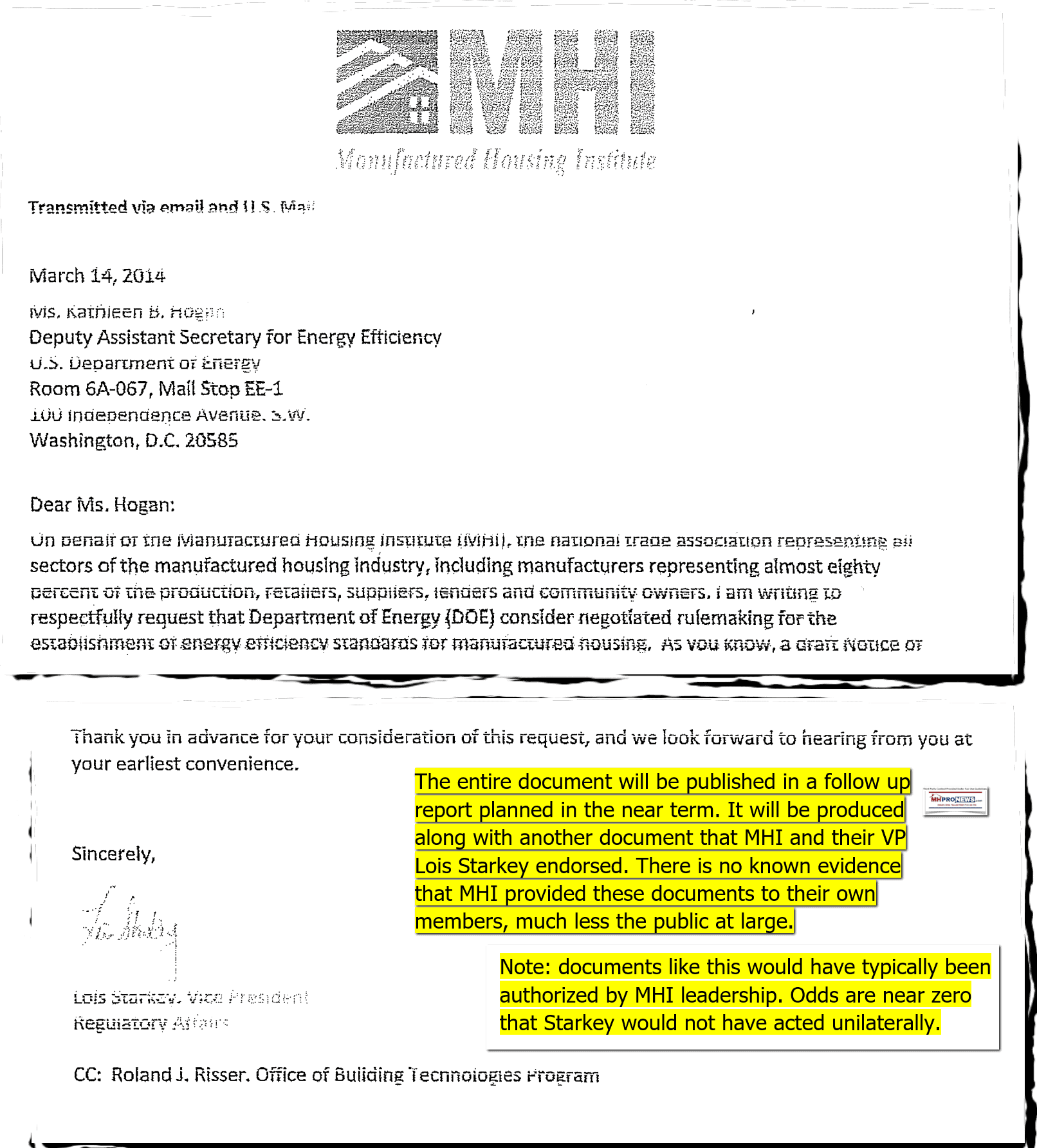
The Daily Business News on MHProNews report yesterday revealed in bright-line distinction fashion how MHI is often on the apparent ‘wrong side’ of so many issues that face our industry. They may seemingly say the right things. But when it comes down to the behavior that follows nice sounding words, MHI and its dominating brands can demonstrably be shown by facts and evidence that their words often do not to match their deeds.
As but one more example, our Sunday weekly recap report demonstrated, MHI had access to a multi-year HUD insider. That insider could have provided MHI with epic evidence useful to spur enforcement of existing laws that would yield historic manufactured housing industry growth.
This troubling pattern begs the question. How is it possible that MHI so routinely seems to say the correct things, but then does the wrong things?
The answer should be as obvious as it is revolting.
- Namely, as Samuel Strommen with Knudson Law, Marty Lavin. J.D., – MHI award winner – and longtime member, MHARR, the Modular Home Builders Association (MHBA) Tom Hardiman, and others have claimed, MHI is engaged in apparently deceptive behavior.
- Behind that deception is the goal, as Kevin Clayton put it in describing their moat in manufactured housing of making it hard on competitors.
- This has been confirmed by Warren Buffett and pro-Buffett sources.
- The upshot of this pattern is industry consolidation into the hands of companies that are routinely MHI members. Several MHI members admit their focus on consolidation in published statements to investors.
- Restated, there is ample prima facie evidence that support the concerns which MHI won’t publicly debate.
Near the heart of what has gone wrong with manufactured housing in the 21st century, a key reason for the industry’s underperformance, is the aim of Berkshire Hathaway and their allies of getting and keeping manufactured housing as a smaller industry than it was for so many decades previously. Two good laws that aimed to increase the industry were magically twisted in a manner that have kept key provisions from being fully and properly implemented.
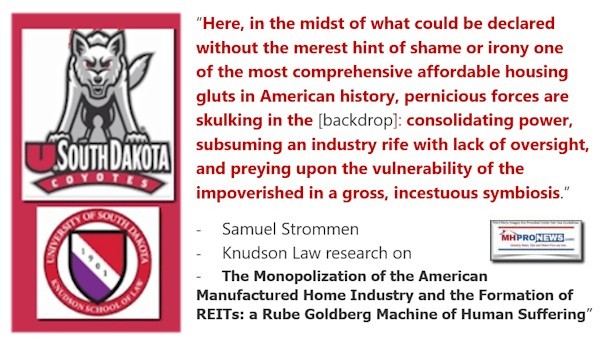
The linked reports provide the evidence for those claims.
To keep it simple, smarty (KISS) – MHI simply can’t have it both ways.
- MHI’s Lesli Gooch has admitted at various times in writing that the MHIA and the Duty to Serve Manufactured Housing (DTS) imposed on Fannie Mae and Freddie Mac have not been properly implemented.
- If so, and there is widespread agreement on those claims, and given that MHI have the demonstrated access and self-proclaimed clout to get congressmen and senators to ask the questions that they want asked, and they can get media coverage when they want to, then why are those good laws not properly implemented?
Something similar, perhaps as or more treacherous, is arguably evidenced in this DOE energy process. MHI deliberately told DOE one thing, and per the research shown below based on their own communications – MHI failed to tell MHI members what they asked the DOE, behind-the-scenes to do.
That is apparent treachery of a high order.
It would be a mistake to think that this only happens in manufactured housing, would be an argument that looking at the broader research by James A “Jim” Schmitz Jr. and his colleagues have shed on how monopolistic forces operate in the modern and prior eras.
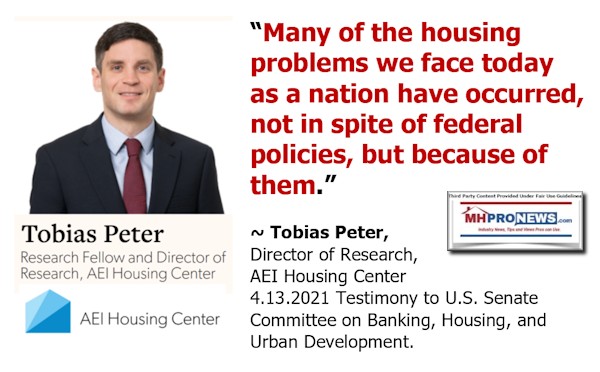
The solution to this is:
- first awareness.
- Then understanding and integration of that knowledge that goes deeper than mere awareness.
- Third, it should be obvious that certain industry members are feeding the hand that is biting them. Why pay for your own risk or destruction?
- Fourth, a case can be made that MHI operates more like a blend of a confidence game and protection racket subject to RICO action than an authentic trade group.
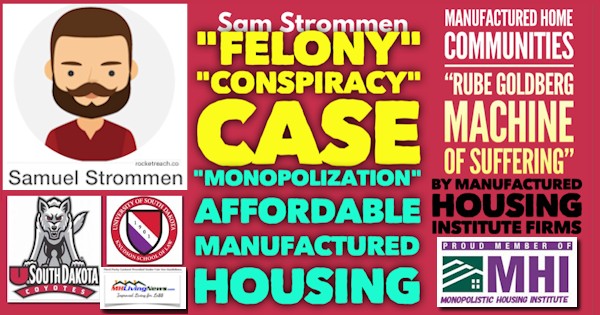
What MHARR has done in the past is expose the treachery, and then fight to expose and stop their efforts in Washington. But in the Biden-era, with Warren Buffett, Bill Gates, and their Civic Alliance ilk in the apparent ascendancy, it is not a given that the legal mechanism will work without prompting.

Thus, there is a need to draw as much attention to such matters as possible. That should be combined with outreaches to those public officials and lawmakers who authentically want the American way of life instead of some autocratic fascist system that journalists such as Glenn Greenwald and others across the left-right divide have warned Americans about.
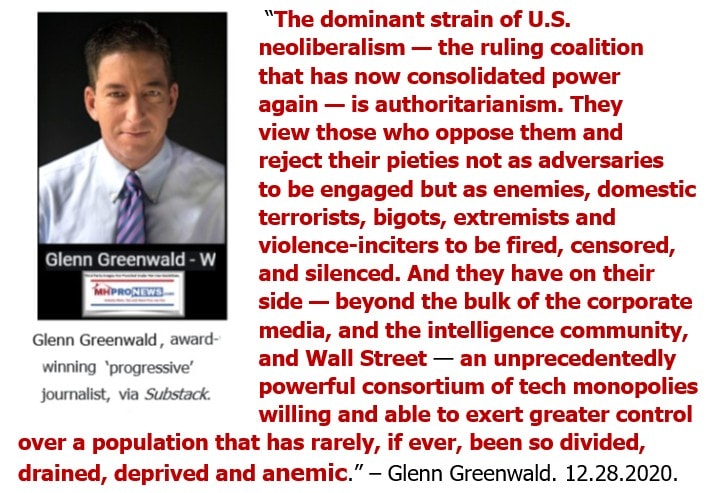
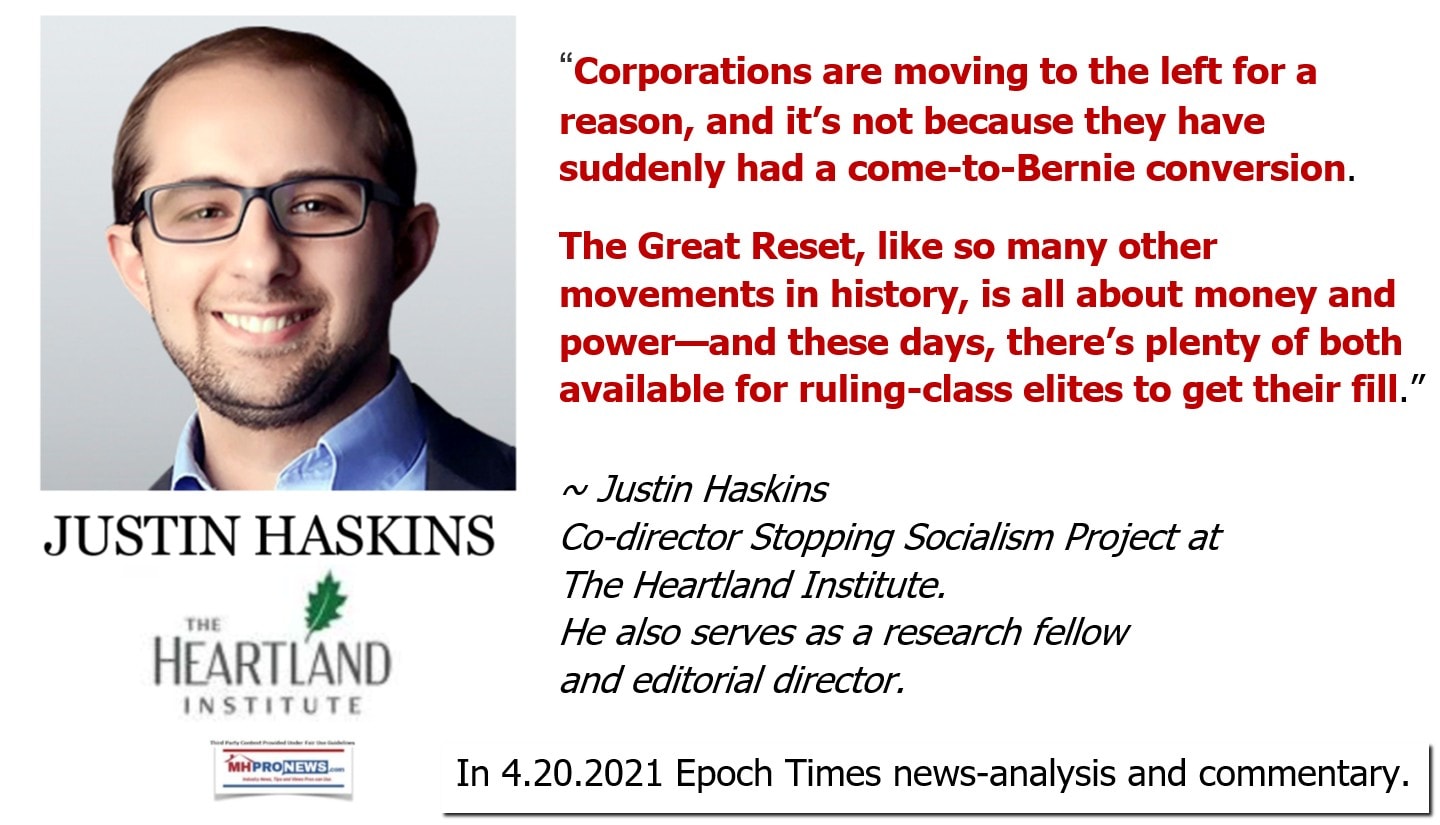
MHARR has carefully documented that this DOE process is a sham. MHProNews has, thanks to documents obtained from DOE, confirmed what MHARR has claimed.
Fear is at times a tool of racketeers. But allowing fear to reign is precisely what will be costly. Courage is not being without fear, courage is the wisdom to face one’s fear and battle anyway for what is right, true, and just.
The battle with the monopolizers of our industry has been on for years. Buckle up for more ahead.
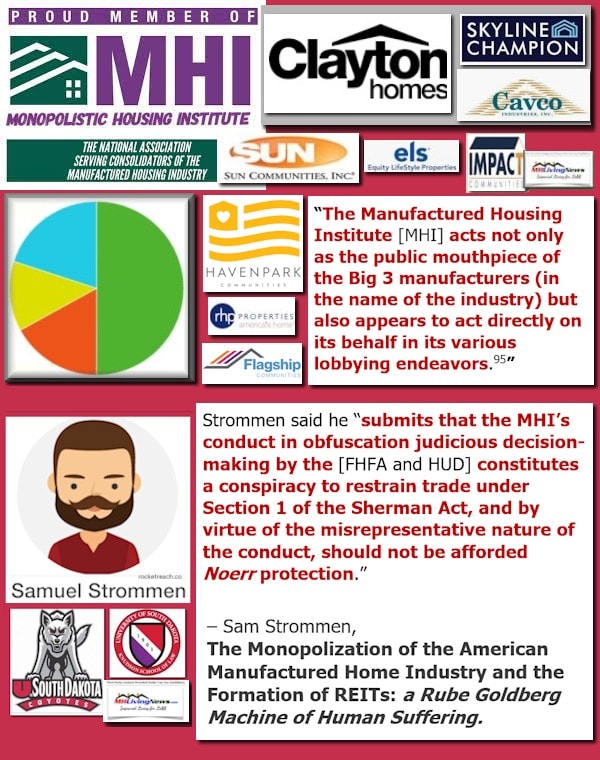



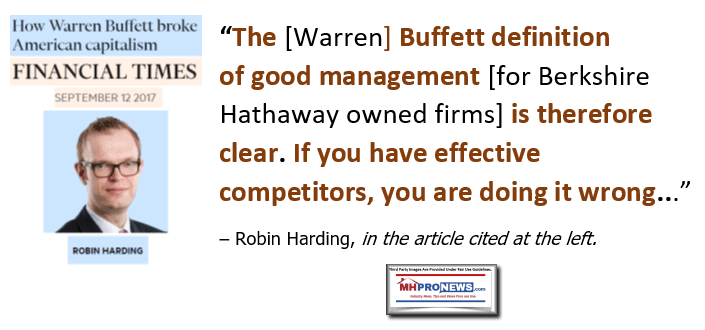
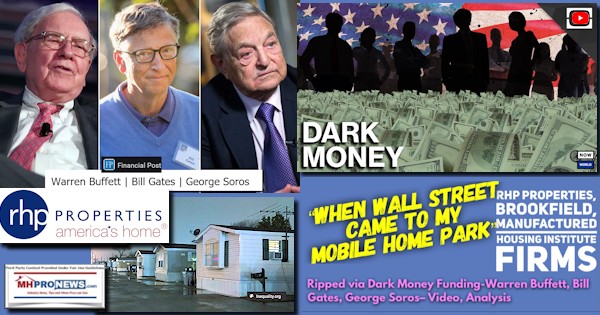
Next up is our business daily recap of yesterday evening’s market report, related left-right headlines, and manufactured housing connected equities.
The Business Daily Manufactured Home Industry Connected Stock Market Updates. Plus, Market Moving Left (CNN) – Right (Newsmax) Headlines Snapshot. While the layout of this daily business report has been evolving over time, several elements of the basic concepts used previously are still the same. For instance. The headlines that follow below can be reviewed at a glance to save time while providing insights across the left-right media divide. Additionally, those headlines often provide clues as to possible ‘market-moving’ news items.
Market Indicator Closing Summaries – Yahoo Finance Closing Tickers on MHProNews…
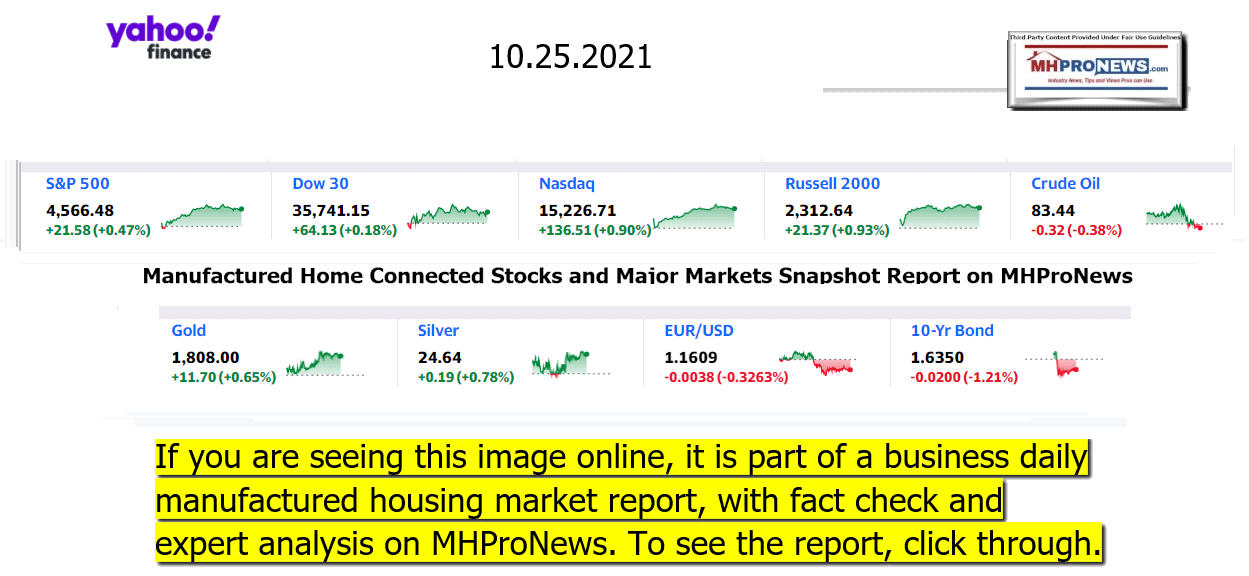
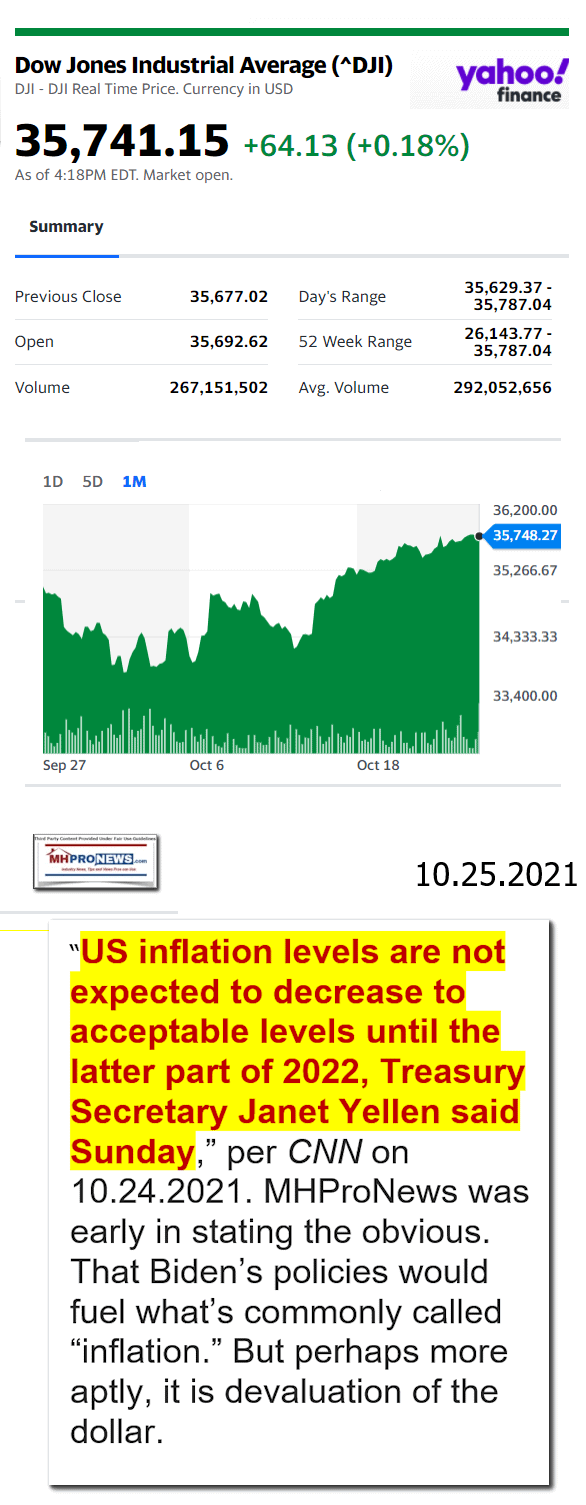
Headlines from left-of-center CNN Business – from the evening of 10.25.2021
- ANALYSIS Wall Street sends a clear message to Facebook
- Its history is littered with scandals. This one could change everything.
- HIGHLIGHTS Whistleblower testifies in the UK
- Testimony: Haugen says Facebook has a ‘huge weak spot’ when it comes to reporting issues up the chain
- Memos: Facebook’s own research showed they should fact-check politicians. Instead, they let them lie.
- Context: What are the Facebook Papers?
- Warned: Facebook staff this weekend were told to brace for “more bad headlines”
- Whistleblower: Facebook views safety as a cost center instead of growth center
- Facebook knew it was being used to incite violence in Ethiopia. It did little to stop the spread, documents show
- Former Facebook employee speaks to CNN
- Opinion: Don’t change your name — change your CEO
- Facebook to hire 10,000 people in EU to build the ‘metaverse’
- The Facebook logo is displayed during the F8 Facebook Developers conference on April 30, 2019 in San Jose, California.
- Abused and exploited: Facebook has a human trafficking problem
- Revealed: How Facebook promoted QAnon to a ‘North Carolina mom’
- Instagram promoted pages glorifying eating disorders to teen accounts
- Backstory: How a LinkedIn message paved the way for ‘The Facebook Files’
- Banned: The sale of protected Amazon rainforest land is now prohibited on Marketplace
- These Trump supporters would rather go to ‘Facebook jail’ than stop sharing misinformation
- Stelter on Facebook: Months of scandal, then a name change?
- Opinion: These revelations are shocking. But nothing will change until Congress acts
- Here’s how to spot misinformation online
- Tech billionaire: Facebook is what’s wrong with America
- Algorithms made Facebook a success. Can they also fix it?
- Here’s how to delete your Facebook account
- $1 trillion company
- The logo marks the showroom and service center for the US automotive and energy company Tesla in Amsterdam on October 23, 2019. (Photo by JOHN THYS / AFP) (Photo by JOHN THYS/AFP via Getty Images)
- Tesla became the 6th company in US history to reach the landmark
- The Dow and S&P 500 hit record highs as Tesla stock electrifies
- Companies may be free from Biden’s proposed 28% corporate tax rate. Here’s why
- Oil surpasses $85 for the first time in seven years
- $24 billion in goods is floating outside California’s biggest ports
- China says it will cut fossil fuel consumption to 20% by 2060
- Evergrande wants to build electric cars, not homes
- Visualizing California’s stunning shipping gridlock
- PayPal says it’s not looking to buy Pinterest
- Everything is still getting more expensive
- Hertz is buying 100,000 Teslas
- Shiba inu coin, a meme cryptocurrency, hits all-time high
- Trump SPAC skyrockets as much as 1,657% since deal was announced
- ‘Dune’ caps off solid month for movie theaters with strong opening
- Content by Quicken Loans
- Recalculate your new house payment
- MORE TOP STORIES
- Jeff Bezos wants to build a tourism space station nearly as big as the ISS
- During a search of Lori Ann Talens’ home, agents found thousands of counterfeit coupons, rolls of coupon paper, and coupon designs for more than 13,000 products on her computer.
- Extreme couponers were sent to prison in $31.8 million fraud scheme
- This photo taken on August 4, 2020 shows Prince, a member of the hacking group Red Hacker Alliance who refused to give his real name, using his computer at their office in Dongguan, China's southern Guangdong province. – From a small, dingy office tucked away in an industrial city in southern China, one of China’s last “volunteer hacker” groups maintains a final outpost in its patriotic hacking war. The erroneous mention[s] appearing in the metadata of this photo by NICOLAS ASFOURI has been modified in AFP systems in the following, we removed the HOLD HOLD HOLD in the main caption. Please immediately remove the erroneous mention[s] from all your online services and delete it (them) from your servers. If you have been authorized by AFP to distribute it (them) to third parties, please ensure that the same actions are carried out by them. Failure to promptly comply with these instructions will entail liability on your part for any continued or post notification usage. Therefore we thank you very much for all your attention and prompt action. We are sorry for the inconvenience this notification may cause and remain at your disposal for any further information you may require.
Russian group that hacked SolarWinds is still attacking America’s computer networks
Headlines from right-of-center Newsmax – evening of 10.25.2021
- Biden FEMA Denies Texas Appeal for Border Crisis Emergency Funds
- The Biden administration refused Gov. Greg Abbott’s appeal that the federal government reimburse Texas for millions of dollars spent responding to the migrant crisis at the southern border. [Full Story]
- Related Stories
- 2,000 Migrants Continue Trek Through Southern Mexico
- Unprecedented 125K Unaccompanied Children Have Shown Up at Border Under Biden
- Fallon to Newsmax: Democrats to Blame for Ongoing Migrant Surge
- Newsmax TV
- Fallon: Democrats to Blame for Ongoing Migrant Surge | video
- Hinson: Administration ‘Turned a Blind Eye’ to Border | video
- Dershowitz: Justices ‘Good and Decent’ But Still ‘Political’ | video
- Texas AG ‘Hopeful’ Supreme Court Will Recognize His State’s Authority to Protect Life | video
- Fitzgerald: AG Garland Ducked GOP Questions
- Yair Netanyahu: ‘Outrageous’ to Reopen Jerusalem Consulate | video
- Trump Jr.: Fauci, Collins Will Blame Others for Gain-of-Function ‘Lies’ | video
- Blackburn: Legislation Protects Workers From Biden Mandate | video
- More Newsmax TV
- Newsfront
- Biden’s Approval Ratings Average Sinks to New Low
- President Joe Biden still has some favorable polls backing his administration amid struggles, but the average of the polls by analyst FiveThirtyEight has the president’s approval rating average hitting new a low…… [Full Story]
- Related Stories
- Rasmussen Poll: Only 30% View AG Merrick Garland Favorably
- Stocks Tick Further into Record Heights on Wall Street
- Wall Street notched some more record highs on Monday as a [Full Story]
- COVID Cases Falling, but Trouble Signs Arise as Winter Looms
- Tumbling COVID-19 case counts have some schools around the U.S. [Full Story]
- Trump Hits Fox for Running Pro-Democrat Ads
- Former President Donald Trump on Sunday slammed Fox News for running [Full Story]
- Related
- Fox’s Chris Wallace Praises Psaki: ‘One of Best Press Secretaries’
- State Dept. Tested Diplomats For ‘Directed Energy Exposure’ Years Before Telling Congress
- The State Department was looking at directed-energy weapons as a [Full Story]
- Enes Kanter Doubles Down on China Slam, Putting NBA in Awkward Spot
- Beijing is once again seething due to a tweet from a high-profile NBA [Full Story] | platinum
- 2 Border Agents Fired for Offensive Facebook Posts
- Two Border Patrol agents were fired from among 60 found to have [Full Story]
- Biden vs. His White House on Taiwan
- For the second time in two months – and just days after news broke [Full Story] | platinum
- ‘Brain Fog’ Continues Long-Term for Many Recovering From COVID
- Even months after beating COVID-19, many people still suffer memory [Full Story]
- Fauci: Vaccines for Kids Ages 5 to 11 Likely Available Next Month
- Vaccines for kids between the ages of 5 and 11 will likely be [Full Story]
- Related
- Moderna’s COVID-19 Vaccine Protective, Safe in Young Children
- Merck Asks EU to Authorize COVID Treatment Pill
- Turkey’s Erdogan Lifts Threat to Expel Western Ambassadors
- Turkish President Recep Tayyip Erdogan late Monday stepped back from [Full Story]
- US Patience With Iran ‘Wearing Thin’ on Nuclear Talks
- The Biden administration said Monday that diplomatic efforts to get [Full Story]
- Fox Weather Channel to Embrace Climate Change
- Fox Weather, the new 24-hour sister network of Fox News, is launching [Full Story]
- Biden FEMA Denies Texas Appeal for Border Crisis Emergency Funding
- The Biden administration refused Gov. Greg Abbott’s appeal that the [Full Story]
- 2,000 Migrants Continue Trek Through Southern Mexico
- More than 2,000 mostly Central American migrants walked along a [Full Story]
- State Department Creates Positions to Combat International Cybersecurity Threats
- The State Department is responding to international cyber threats [Full Story]
- Biden Education Department Warns Florida Over Defunding School Districts
- The U.S. Department of Education on Monday sent a letter to Florida [Full Story]
- US Details New International COVID-19 Travel Requirements
- Two weeks before a new vaccination requirement kicks in for most [Full Story]
- US Embassy Tells Americans in Sudan to ‘Shelter in Place’
- Due to the coup in Sudan, the U.S. Embassy in Khartoum on Monday [Full Story]
- Washington Post Issues Correction on ‘Let’s Go Brandon’ Chant
- The Washington Post was forced to issue a correction on a story that [Full Story]
- Biz Groups Ask Delay Of Biden Vax Mandate Until After Holidays
- Business groups are asking the Biden administration to delay its [Full Story]
- Georgia Gov. Kemp: Abrams Should Not Have Injected Politics in Baseball
- It was “ridiculous to inject politics into sports” earlier this when [Full Story]
- Hostage Families to Biden: ‘Bring Our Fellow Americans Home’
- Relatives of more than two dozen American hostages and wrongful [Full Story]
- Judge: Pablo Escobar’s Cocaine Hippos Legally ‘People’
- The offspring of hippos once owned by Colombian drug kingpin Pablo [Full Story]
- Rasmussen Poll: Only 30 Percent View AG Merrick Garland Favorably
- More likely voters have an unfavorable than favorable impression of [Full Story]
- Dem Rep. Brown Announces He’s Leaving House to Run for Maryland AG
- Anthony Brown, D-Md., announced Monday he’ll run for attorney [Full Story]
- Kerry Holds $1M Stake in Chinese Equity Fund Linked to Rights Abuses
- Biden administration climate czar John Kerry holds a $1 million stake [Full Story]
- Florida Surgeon General Refuses to Wear Mask at State Senate Office
- Florida Surgeon General Dr. Joseph Ladapo was asked to leave State [Full Story]
- Hawley: AG Garland Must Step Down Over Call to Investigate Parents
- Josh Hawley Monday called for Attorney General Merrick Garland’s [Full Story]
- Parts of Northern China in Lockdown as COVID Spreads
- Chinese authorities across the northern region of the country are [Full Story]
- Hertz Orders 100,000 Teslas
- Hertz on Monday announced an order of 100,000 Tesla Inc cars, taking [Full Story]
- One Simple Method to Keep Your Blood Sugar Below 100
- Glucofort
- More Newsfront
- Finance
- Desperate for Employees, US Businesses Struggle to Hire
- To keep the taps at his recently opened beer tasting room flowing, Peter Chekijian had no choice but to ask his main employees to come in seven days per-week.The staffing shortage has also kept Chekijian from realizing his goal of brewing beer on site, since he can’t find… [Full Story]
- A ‘V’, ‘K’- or a ‘Z’-Shaped Recovery?
- Cryptocurrencies Post Record Inflows in Latest Week
- NTSB Chair Wants Tesla to Limit Where Autopilot Can Operate
- Busler: Biden Taxes in $3.5T Bill Would Stagnate Economy
- More Finance
- Health
- What Side Effects Can You Expect After a Booster Shot?
- A month ago, the Food and Drug Administration authorized specific populations to be eligible for the Pfizer COVID-19 booster. On Thursday, the Centers for Disease Control and Prevention (CDC) recommended that certain individuals are eligible for booster shots of all three… [Full Story]
- Vaccinated People Less Likely to Die of Any Cause: Study
- Pancreatic Cancer Cases Rising in Young Women
- Moderna’s COVID-19 Vaccine Protective, Safe in Young Children
- Implant for Chronic Eye Disorder Wins FDA Approval
Manufactured Housing Industry Investments Connected Equities Closing Tickers
Some of these firms invest in manufactured housing, or are otherwise connected, but may do other forms of investing or business activities too.
-
-
-
-
-
-
-
-
-
-
-
-
- NOTE: The chart below includes the Canadian stock, ECN, which purchased Triad Financial Services, a manufactured home industry lender
- NOTE: Drew changed its name and trading symbol at the end of 2016 to Lippert (LCII).
- NOTE: Deer Valley was largely taken private, say company insiders in a message to MHProNews on 12.15.2020, but there are still some outstanding shares of the stock from the days when it was a publicly traded firm. Thus, there is still periodic activity on DVLY.
-
-
-
-
-
-
-
-
-
-
-
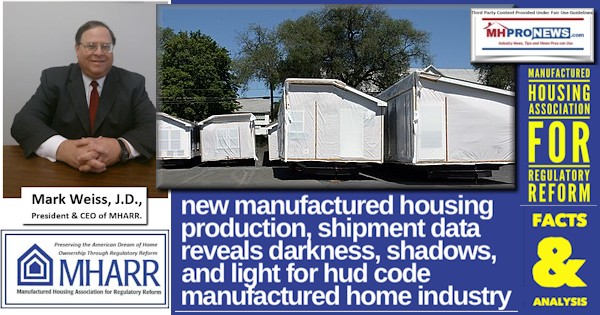
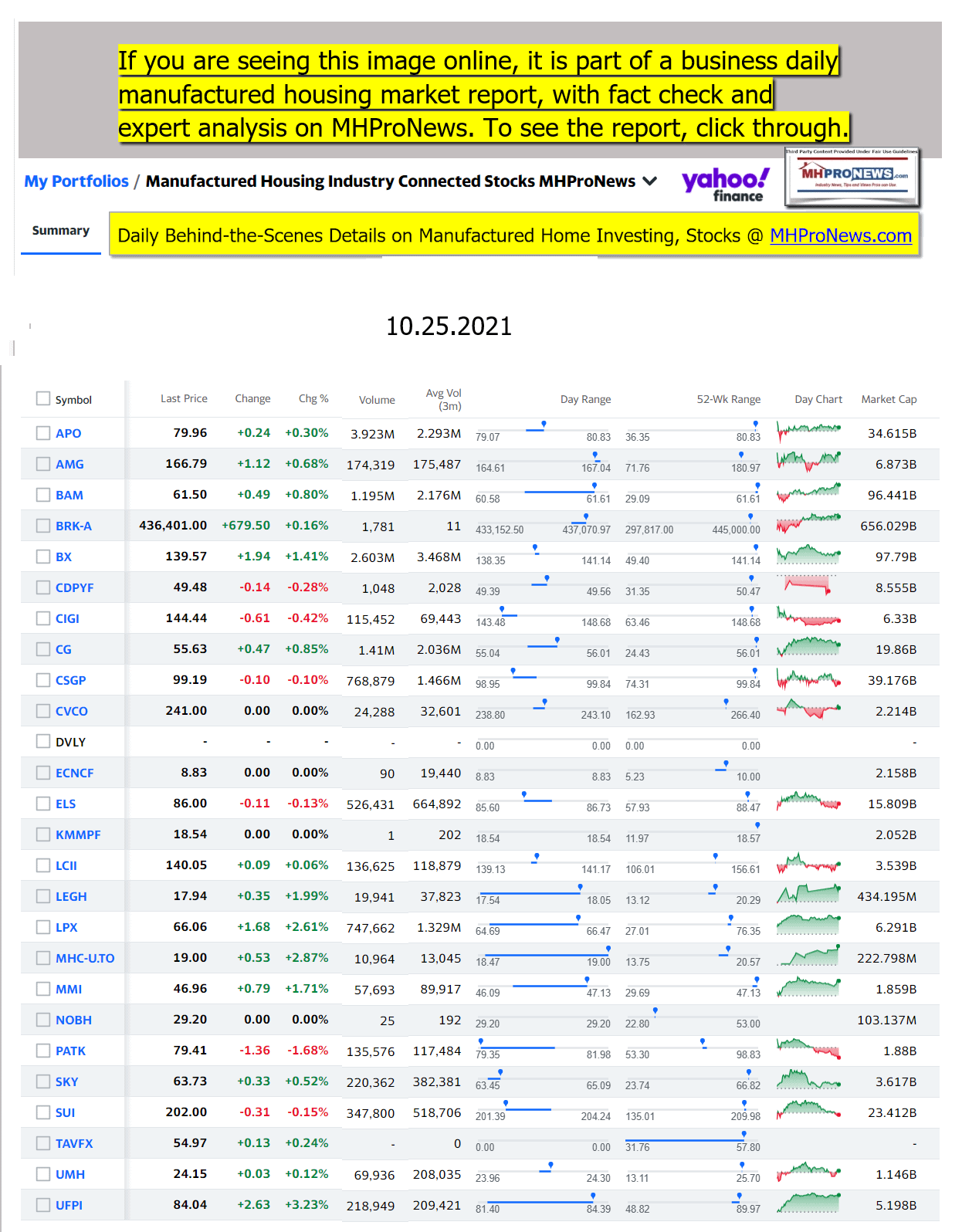
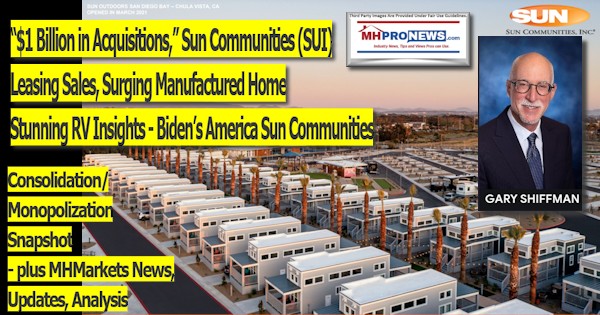

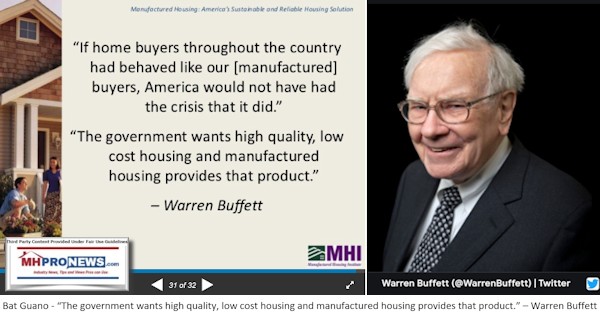


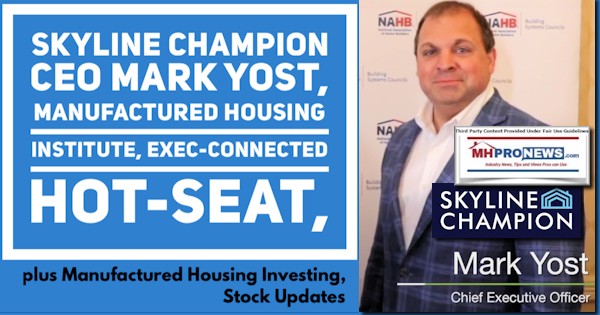
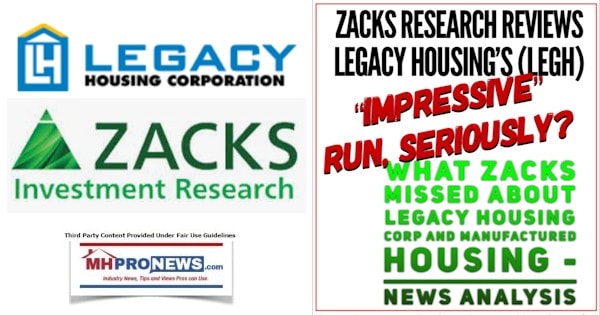
As the Summer of 2021 draws to a close…
Berkshire Hathaway is the parent company to Clayton Homes, 21st Mortgage, Vanderbilt Mortgage and other factory built housing industry suppliers.
· LCI Industries, Patrick, UFPI, and LP each are suppliers to the manufactured housing industry, among others.
· AMG, CG, and TAVFX have investments in manufactured housing related businesses. For insights from third-parties and clients about our publisher, click here.
Enjoy these ‘blast from the past’ comments.
MHProNews. MHProNews – previously a.k.a. MHMSM.com – has celebrated our 11th year of publishing, and is starting our 12th year of serving the industry as the runaway most-read trade media.
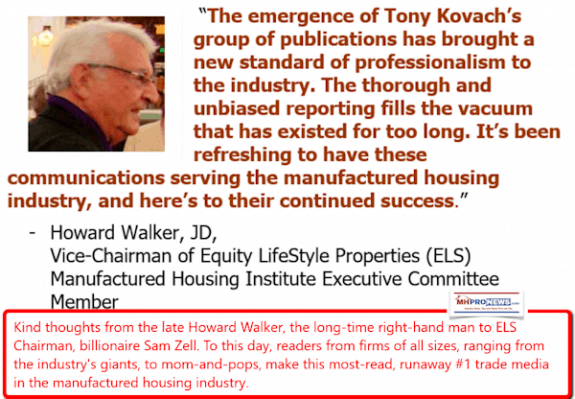
Sample Kudos over the years…
It is now 11+ years and counting…
Learn more about our evolutionary journey as the industry’s leading trade media, at the report linked below.
· For expert manufactured housing business development or other professional services, click here.
· To sign up in seconds for our industry leading emailed headline news updates, click here.
Disclosure. MHProNews holds no positions in the stocks in this report.
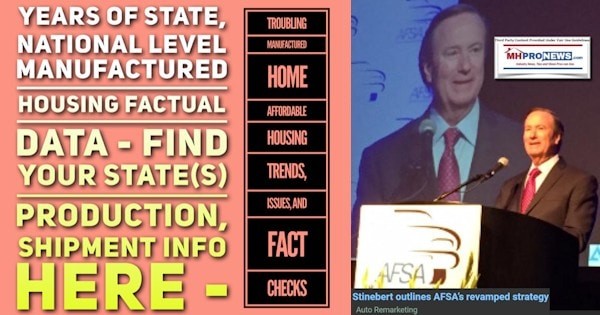



That’s a wrap on this installment of “News Through the Lens of Manufactured Homes and Factory-Built Housing” © where “We Provide, You Decide.” © (Affordable housing, manufactured homes, stock, investing, data, metrics, reports, fact-checks, analysis, and commentary. Third-party images or content are provided under fair use guidelines for media.) (See Related Reports, further below. Text/image boxes often are hot-linked to other reports that can be access by clicking on them.)

By L.A. “Tony” Kovach – for MHProNews.
Tony earned a journalism scholarship along with numerous awards in history. There have been several awards and honors and also recognition in manufactured housing. For example, he earned the prestigious Lottinville Award in history from the University of Oklahoma, where he studied history and business management. He’s a managing member and co-founder of LifeStyle Factory Homes, LLC, the parent company to MHProNews, and MHLivingNews.com. This article reflects the LLC’s and/or the writer’s position, and may or may not reflect the views of sponsors or supporters.

